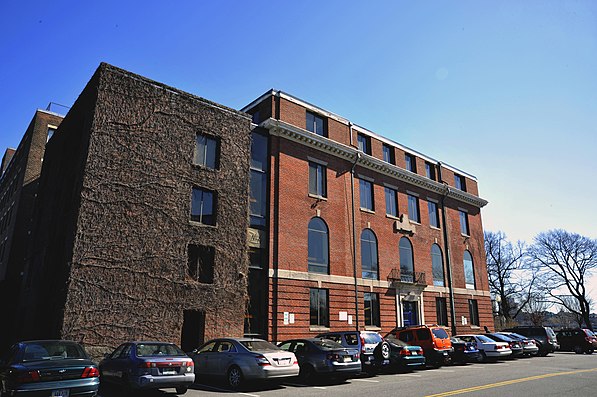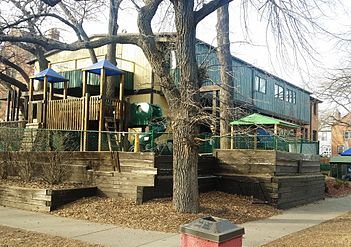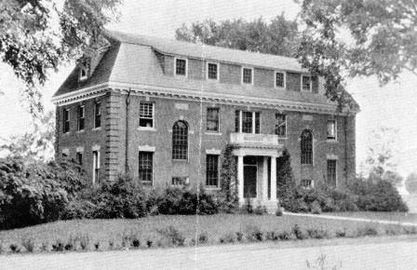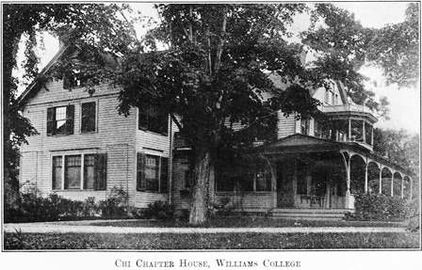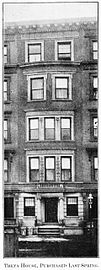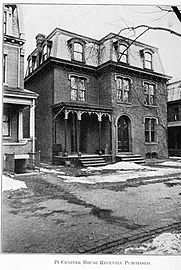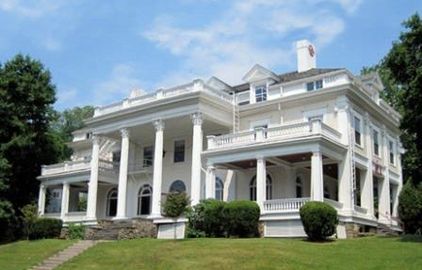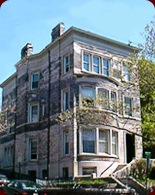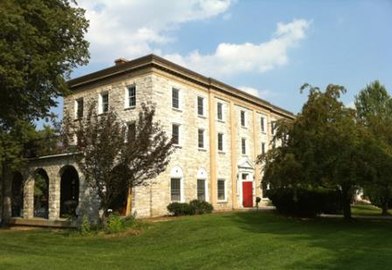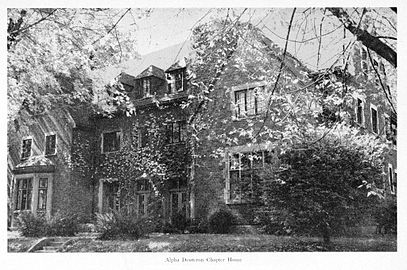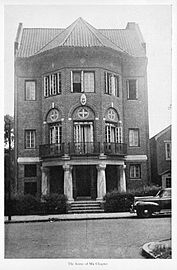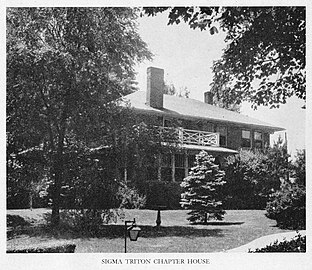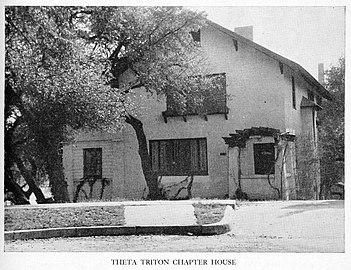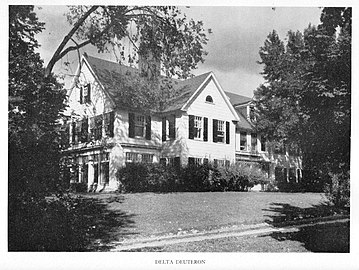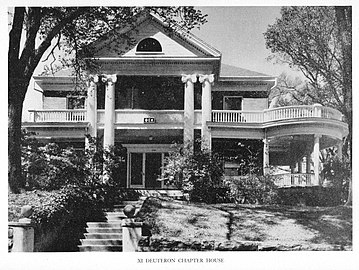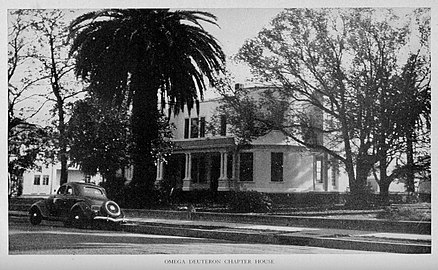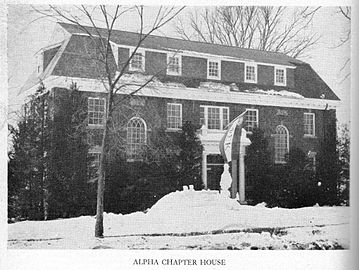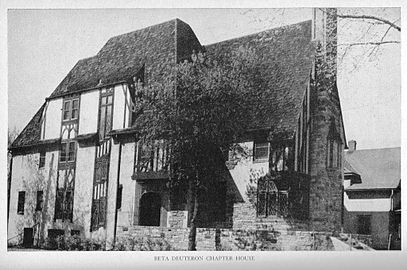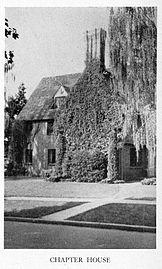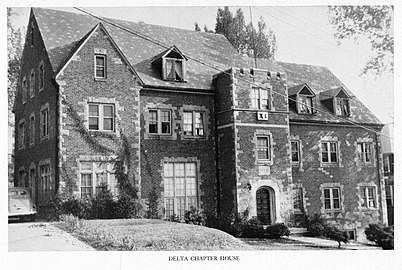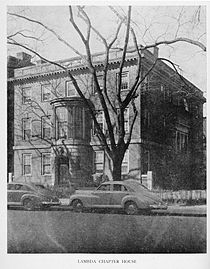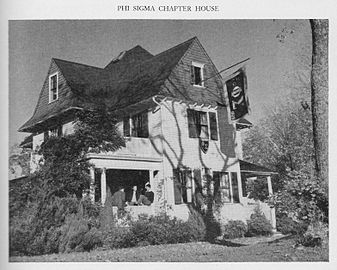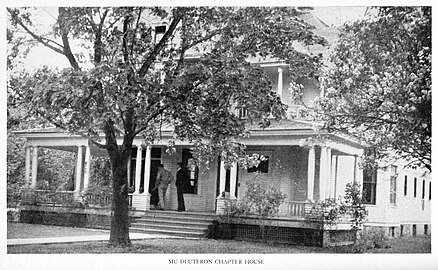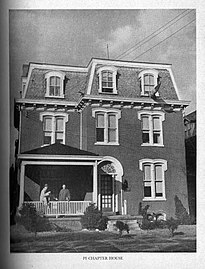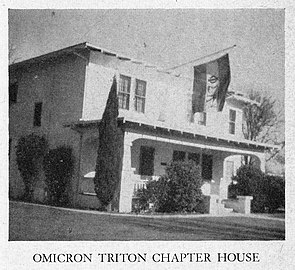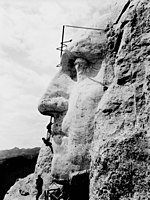-
Construction on the George Washington portrait at Mount Rushmore, c. 1932.
-
Washington is commemorated on the quarter.
-
Washington is also commemorated on some dollar coins.
What this page is:
This is Jax_MN's user sandbox, a testing area for formatting and writing large sections of edits over time. It is not a public page.
If you wish to leave me a comment, go to my Talk page instead.
Link to my other sandboxes
- User:Jax MN/sandbox/PiBeta PhiChapters - Began working on this 6 March 2024. Completed.
- User:Jax MN/sandbox/SigmaThetaEpsilonChapters - Began working on this 21 March 2024. Completed.
- User:Jax MN/sandbox/PhiKappaSigmaChapters - began working on this 8 April 2024. Completed.
Pending comment for MIT AfD nonsense
Pending comment for the AfD on the MIT page. Friends, I had no connection to this article nor this school when I waded in, approximately 10 days ago. I like the fact of the list, although I agree it had been poorly written and sourced. So I replaced it. I replaced it with one more cleanly written, with decent formatting and graphics, and with ten times the references. These were what I thought were substantial, quality references. I only had "7 days" to make my case, because for some reason this article was nominated as an AfD. I frankly thought I overdid what was needed, for citations. But behold, I hadn't yet won my case. I'm left to consider two conclusions: 1. These solid references I provided, following the model of hundreds, maybe thousands of other such groups and the colleges they serve, are suspect, and therefore many others should be at risk of deletion, or, 2. Someone has a bias, and is not acting in good faith with pursuit of deletion.
There are many minor, frivolous, and poorly written pages on Wikipedia. I do not have the time to chase most of them down. I suggest that since this page has been improved to a point where a disinterested editor would have to agree it is at least as good as many within its class, that there are other articles with more serious need for cleanup than this one. There are other windmills with which to joust.
MIT Fraternities intro

Following this historical summary is a comprehensive list of MIT's Fraternities, Sororities and Independent Living Groups (ILGs). This title is often abbreviated as FSILG.
The first, or pioneer fraternity on the MIT campus was Chi Phi, established in 1873. [1] However many of the early professors and deans of the Institute held fraternity memberships from their own collegiate days, as by the time MIT and Chi Phi appeared fraternities had already been thriving on America's earliest campuses for almost 100 years. [2]
Almost 150 years later, as of 2020, MIT hosts 30 academic fraternities, 11 academic sororities, 40 national or local honors societies and recognition organizations, 2 professional societies, 5 Independent Living Groups, and 1 service- or religious-focused chapter. [3]
Within this article, the terms "Fraternity" and "Sorority" are used somewhat interchangeably, with men's and co-ed groups normally using Fraternity, and women's groups using either Fraternity or Sorority. For convenience, the term "Greek Letter Society" is a generic substitute. The word, "Greek," in this case refers to the use of Greek Letters for each society's name, and not to Greek ethnicity. For brevity, the sections below make extensive use of Greek letters, one of the first items in a new member's instruction program. Most fraternities use two or three Greek letters to signify their symbolic or secret names; a few use non-Greek words. [4] The main listing for each fraternity or sorority shows their full name at least once, with references and Wikilinks as available.
MIT FSILG history
Many MIT fraternities are located in Boston because the Institute was originally located in the Back Bay neighborhood, and had no dormitories to house its students. The fraternities and various dining clubs met a need for room and board that was not provided by the operations of the campus. Fraternity housing has continued to expand, both in terms of the size and quality of the individual buildings as well as the number of chapters. In 1900 the percentage of fraternity men at "Technology", as was the name of the school at that time, was 16.1%; today the percentage is over 50% of men, and 35% of women. [5] Several of MIT's fraternity buildings are today listed on the National Register of Historic Places or are otherwise notable. These include former governors mansions, college deans mansions, and homes of various early leaders who once resided there. Quality facilities remain a focus for many groups. A cursory search of Institute yearbooks will show that dining, and later, fine dining, has remained of particular interest to participants. Many chapters and ILGs extol the quality of their gourmet or commercial kitchens in their photo tours and rush materials.

MIT moved to its Cambridge campus in 1916, and newer independent living groups have sprouted up or moved in around it. Many early chapters had been situated along Newbury Street, convenient to the old campus, but because of the move, today, MIT doesn't have a specific Greek Row; instead, chapters are scattered on both sides of the Charles River in Boston, Cambridge and the surrounding towns. 1916 also saw the emergence of the campus Inter-fraternity Conference. Its responsibilities included coordination of recruitment (rush), intermural Greek athletics such as baseball and bowling, among other competitions. One early tradition established by the IFC with support of 'Tech faculty was a trophy for the best scholarship record. This handsome grandfather clock would be passed on to the chapter with the best overall grade average at the completion of each term. [6]
The MIT yearbook, The Technique, has provided a window to the growth and popularity of MIT's Greek organizations for almost 150 years. Early editions are available online.
Demographic Changes
From the 1860s through WWII, MIT students were almost entirely male, thus the formation of women's fraternities (~sororities) came about rather late, in comparison. By the 2000s, the Institute's undergraduate gender ratio reached near parity. En route to this more balanced, modern phase, a period of demographic and political change in the 1960s and 1970s, following larger national trends, resulted in the conversion of several all-male, nationally affiliated living groups into local co-ed groups, and led to the expansion of all-female and co-ed housing options. Most of the resultant fraternities, sororities and independent living groups are coordinated through the Office of Fraternities, Sororities and independent Living Groups (FSILGs), though some independent MIT chapters do arise from time to time, along with those that serve students from multiple schools in Boston and the surrounding cities.
Recruitment Traditions
Traditionally, rush at MIT occurred during "Residence/Orientation" (R/O) Week, which was the final week of each summer before the start of the fall semester. All incoming freshmen and transfer students would arrive on campus a week before Registration Day, the official start of the fall semester. During R/O Week, the incoming class would participate in orientation activities, take the so-called "writing test" to attempt to test out of the MIT Writing Requirement, and participate in residence selection. All students were free to participate in fraternity, sorority and independent living group rush. Those students who did not end up in an off-campus living group would also participate in the dorm selection process (see " List of Massachusetts Institute of Technology undergraduate dormitories").
FSILG rush was an intense experience for all involved, cramming the entire process of choosing among dozens of housing options into essentially three days. It always began with an event known as the "Killian Kickoff," held in Killian Court in the middle of campus. MIT's president would deliver a welcoming speech to the incoming class, which always ended with, "Let the rush begin!" Immediately, upperclassmen removed their overshirts to display their letters (an upperclassman wearing anything which identified his or her living group prior to the start of rush was a serious violation of rush rules), and fanned out through the crowd in search of freshmen. For the incoming students, rush was a whirlwind of cookouts, parties and field trips all over the Boston area. For the upperclassmen, it was a marathon of 18-hour days, trying to meet as many freshmen as possible while competing with other living groups for the most popular prospects. For both sides, rush could be stressful, exhausting, and highly emotional. In many ways, rush was a high-pressure, compressed microcosm of the broader MIT experience.
Old Rush Gives Way to New Rush
The old rush system was supported behind the scenes by the 24-hour week-long "R/O Clearinghouse", a system for keeping track of freshman students as they threaded their way through a maze of fraternity rush events interleaved with other MIT orientation activities. Whenever a freshman "checked into" or "checked out of" a fraternity activity, that frat's R/O liaison person was supposed to call the R/O Clearinghouse to update what was essentially a real-time database to track the whereabouts of the new students. R/O Clearinghouse physically consisted of a bank of telephones staffed by volunteers in a large room equipped with computer terminals, located in the MIT EECS Department. The volunteers were drawn from MIT service fraternities and dorm residents who were supposed to be "impartial" with respect to the different competing fraternities. The dorm volunteers were motivated at least in part by the knowledge that an unsuccessful fraternity rush would result in even greater overcrowding of the MIT dormitory system. which simply lacked the physical space to accommodate every new student.
Freshman housing rush was eliminated in an initiative led by MIT president Charles Vest in the wake of the September 1997 death of Phi Gamma Delta (Fiji) freshman Scott Krueger. [7] Beginning with the 2002 - 2003 academic year, all freshmen were required to live on campus. This was made possible by the completion of a new undergraduate dorm which opened that year, Simmons Hall. Since then, MIT has continued to build or renovate more dormitories, including an expansion of choices for graduate students as well (see " Housing at the Massachusetts Institute of Technology#Graduate_dorms").
A much-toned-down echo of the old rush still occurs with the so-called "dormitory rush" process, in which new students decide their dormitory preferences, based in part upon special events staged by various dorms to introduce newcomers to their distinctive living arrangements. However, dormitories do not "choose" which new students to admit, but can only influence prospective new members to express greater or lesser preference for specific dorms on their respective entries in the dorm lottery process. Pressure to quickly find housing has been lifted by MIT's guarantees that every freshman student will find space in an on-campus dorm, and that undergraduate students can remain in the dorm system for up to 4 years. The old fraternity rush has been depressurized, with recruiting spread out throughout the first academic year, and less-frantic rush events for prospective new members.
MIT's Greek System

Following this historical summary is a comprehensive list of MIT's Fraternities, Sororities and Independent Living Groups (ILGs). This title is often abbreviated as FSILG.
The first, or pioneer fraternity on the campus of the Massachusetts Institute of Technology (MIT) campus was Chi Phi, established in 1873. [1] However many of the early professors and deans of the Institute held fraternity memberships from their own collegiate days, as by the time Chi Phi at MIT had appeared fraternities had already been thriving at America's earliest campuses for almost 100 years. [8] MIT's third president, Francis Amasa Walker was a member of ΔΚΕ as an undergrad at Yale.
Almost 150 years later, as of 2020, MIT hosts 29 academic fraternities, 10 academic sororities, 12 national or local honors societies and recognition organizations, 2 professional societies, 5 Independent Living Groups, and 1 service- or religious-focused chapter. [9]
Within this article, the terms "Fraternity" and "Sorority" are used somewhat interchangeably, with men's and co-ed groups normally using Fraternity, and women's groups using either Fraternity or Sorority. For convenience, the term "Greek Letter Society" is a generic substitute. The word, "Greek," in this case refers to the use of Greek Letters for each society's name, and not to Greek ethnicity. For brevity, the sections below make extensive use of Greek letters, one of the first items in a new member's instruction program. Most fraternities use two or three Greek letters to signify their symbolic or secret names; a few use non-Greek words. [4] The main listing for each fraternity or sorority shows their full name at least once, with references and Wikilinks as available.
MIT FSILG history
Many MIT fraternities are located in Boston because the Institute was originally located in the Back Bay neighborhood, and had no dormitories to house its students. The fraternities and various dining clubs met a need for room and board that was not provided by the operations of the campus. Fraternity housing has continued to expand, both in terms of the size and quality of the individual buildings as well as the number of chapters. In 1900 the percentage of fraternity men at "Technology", as was the name of the school at that time, was 16.1%; today the percentage is almost 50% of men, and 30% of women. [10] Several of MIT's fraternity buildings are today listed on the National Register of Historic Places or are otherwise notable. These include former governors mansions, college deans mansions, and homes of various early leaders who once resided there. [11] Quality facilities remain a focus for many groups. A cursory search of Institute yearbooks will show that dining, and later, fine dining, has remained of particular interest to participants. Many chapters and ILGs extol the quality of their gourmet or commercial kitchens in their photo tours and rush materials.

MIT moved to its Cambridge campus in 1916, and newer independent living groups have sprouted up or moved in around it. Many early chapters had been situated along Newbury Street, convenient to the old campus, but because of the move, today, MIT doesn't have a specific Greek Row; instead, chapters are scattered on both sides of the Charles River in Boston, Cambridge and the surrounding towns. 1916 also saw the emergence of the campus Inter-fraternity Conference. Its responsibilities included coordination of recruitment (rush), intermural Greek athletics such as baseball and bowling, among other competitions. One early tradition established by the IFC with support of 'Tech faculty was a trophy for the best scholarship record. This handsome grandfather clock would be passed on to the chapter with the best overall grade average at the completion of each term. [6]
The MIT yearbook, The Technique, has provided a window to the growth and popularity of MIT's Greek organizations for almost 150 years. Early editions are available online.
Demographic Changes
From the 1860s through WWII, MIT students were almost entirely male, thus the formation of women's fraternities (~sororities) came about rather late, in comparison. By the 2000s, the Institute's undergraduate gender ratio reached near parity. En route to this more balanced, modern phase, a period of demographic and political change in the 1960s and 1970s, following larger national trends, resulted in the conversion of several all-male, nationally affiliated living groups into local co-ed groups, and led to the expansion of all-female and co-ed housing options. Most of the resultant fraternities, sororities and independent living groups are coordinated through the Office of Fraternities, Sororities and independent Living Groups (FSILGs), though some independent MIT chapters do arise from time to time, along with those that serve students from multiple schools in Boston and the surrounding cities.
Recruitment Traditions
Traditionally, rush at MIT occurred during "Residence/Orientation" (R/O) Week, which was the final week of each summer before the start of the fall semester. All incoming freshmen and transfer students would arrive on campus a week before Registration Day, the official start of the fall semester. During R/O Week, the incoming class would participate in orientation activities, take the so-called "writing test" to attempt to test out of the MIT Writing Requirement, and participate in residence selection. All students were free to participate in fraternity, sorority and independent living group rush. Those students who did not end up in an off-campus living group would also participate in the dorm selection process (see " List of Massachusetts Institute of Technology undergraduate dormitories").
FSILG rush was an intense experience for all involved, cramming the entire process of choosing among dozens of housing options into essentially three days. It always began with an event known as the "Killian Kickoff," held in Killian Court in the middle of campus. MIT's president would deliver a welcoming speech to the incoming class, which always ended with, "Let the rush begin!" Immediately, upperclassmen removed their overshirts to display their letters (an upperclassman wearing anything which identified his or her living group prior to the start of rush was a serious violation of rush rules), and fanned out through the crowd in search of freshmen. For the incoming students, rush was a whirlwind of cookouts, parties and field trips all over the Boston area. For the upperclassmen, it was a marathon of 18-hour days, trying to meet as many freshmen as possible while competing with other living groups for the most popular prospects. For both sides, rush could be stressful, exhausting, and highly emotional. In many ways, rush was a high-pressure, compressed microcosm of the broader MIT experience.
Old Rush Gives Way to New Rush
The old rush system was supported behind the scenes by the 24-hour week-long "R/O Clearinghouse", a system for keeping track of freshman students as they threaded their way through a maze of fraternity rush events interleaved with other MIT orientation activities. Whenever a freshman "checked into" or "checked out of" a fraternity activity, that frat's R/O liaison person was supposed to call the R/O Clearinghouse to update what was essentially a real-time database to track the whereabouts of the new students. R/O Clearinghouse physically consisted of a bank of telephones staffed by volunteers in a large room equipped with computer terminals, located in the MIT EECS Department. The volunteers were drawn from MIT service fraternities and dorm residents who were supposed to be "impartial" with respect to the different competing fraternities. The dorm volunteers were motivated at least in part by the knowledge that an unsuccessful fraternity rush would result in even greater overcrowding of the MIT dormitory system. which simply lacked the physical space to accommodate every new student.
Freshman housing rush was eliminated in an initiative led by MIT president Charles Vest in the wake of the September 1997 death of Phi Gamma Delta (Fiji) freshman Scott Krueger. [7] Beginning with the 2002 - 2003 academic year, all freshmen were required to live on campus. This was made possible by the completion of a new undergraduate dorm which opened that year, Simmons Hall. Since then, MIT has continued to build or renovate more dormitories, including an expansion of choices for graduate students as well (see " Housing at the Massachusetts Institute of Technology#Graduate_dorms").
A much-toned-down echo of the old rush still occurs with the so-called "dormitory rush" process, in which new students decide their dormitory preferences, based in part upon special events staged by various dorms to introduce newcomers to their distinctive living arrangements. However, dormitories do not "choose" which new students to admit, but can only influence prospective new members to express greater or lesser preference for specific dorms on their respective entries in the dorm lottery process. Pressure to quickly find housing has been lifted by MIT's guarantees that every freshman student will find space in an on-campus dorm, and that undergraduate students can remain in the dorm system for up to 4 years. The old fraternity rush has been depressurized, with recruiting spread out throughout the first academic year, and less-frantic rush events for prospective new members.
MIT's Fraternities
Fraternities constituting the Interfraternity Council (IFC) are listed by dates of local founding and noted with national conference membership. These are (with several exceptions) men's organizations, voluntarily coordinating their efforts within the IFC as a self-governing body. [12] Almost 50% of campus men participate in one of these chapters. [13]
As part of IFC or national organization self-governance or University disciplinary action, chapters may be suspended ("de-recognized") or closed for a time. For consistency, if a chapter is closed and/or forfeits its housing, it will be listed here as a dormant chapter, italicized, while active chapters or those suspended for a brief time are in bold. See the Office for Fraternities, Sororities and Independent Living Groups (FSILGs) for current IFC members and for expansion support.
- (NIC) indicates current members of the North American Interfraternity Conference;
- (PFA) indicates current and former members of the Professional Fraternity Association;
- (NPHC) indicates members of the National Pan-Hellenic Council.
Images of MIT fraternities
-
Home of Sigma Chi's Alpha Theta chapter at MIT, in 2004
-
Home of "Number Six Club," Delta Psi's Tau chapter at MIT, in 2004
-
Home of Theta Chi's Beta chapter at MIT, in 2008
-
Home of Phi Sigma Kappa's Omicron chapter at MIT, circa 1940s
Contributors: this gallery can accept photos of your building (inside or out, something iconic), as long as they are properly submitted to Wikipedia for use here (~free use copyright). There are separate photo sections for fraternities, sororities and the ILGs. Scroll over for pop-up text.
Active Fraternity Chapters
|
|
|
Chapters whose names changed
|
Dormant Chapters
|
MIT's Sororities
Sororities, listed with dates of local founding and national conference membership, are women's organizations, [86] voluntarily coordinating their efforts within MIT's Panhellenic Association (PHA). [87] For convenience, the term "sorority" is used throughout, though some of these organizations are "women's Fraternities," and were so named prior to the popularization of the term, sorority. The terms are synonymous. Over 30% of campus women participate in one of these chapters. [15]
Sorority properties are generally owned or leased by a chapter's alumni club, though some chapters do not have housing. As part of PHA or national organization self-governance, or University disciplinary action, chapters may be suspended ("de-recognized") or closed for a time. If a chapter is closed and/or forfeits its housing, it will be listed as a dormant chapter. See the office for Fraternities, Sororities and Independent Living Groups (FSILGs) for current PHA members and for expansion support.
- (NPC) indicates members of the National Panhellenic Conference
- (NPHC) indicates members of the National Pan-Hellenic Council
Images of MIT sororities
-
Home of ΑΧΩ's Theta Omicron chapter at MIT
Contributors: this gallery can accept photos of your building (inside or out, something iconic), as long as they are properly submitted to Wikipedia for use here (~free use copyright). There are separate photo sections for fraternities, sororities and the ILGs.
Active Chapters
|
MIT Sororities, Multicultural Greek Council
MIT-Area Sororities, outside of the FSILG
|
Sororities whose names changed
|
Dormant sorority chapters
|
MIT's Independent Living Groups (ILGs)
MIT's Independent Living Groups or ILGs participate in some of the broader Greek events, but maintain many of their own traditions as cooperative homes. Some developed as former fraternities that left their national associations during the early 1970s as part of a move toward co-education which was not compatible with their national organizations. MIT's five ILGs coordinate themselves through a separate Living Group Council (LGC). [100]
ILG properties are generally owned by the organization through a corporation. See the groups themselves or the office for Fraternities, Sororities and Independent Living Groups (FSILGs) for more information.
Images of MIT ILGs
-
Home of pika: A Continuing Experiment in Cooperative Living!
Contributors: this gallery can accept photos of your building (inside or out, something iconic), as long as they are properly submitted to Wikipedia for use here (~free use copyright). There are separate photo sections for fraternities, sororities and the ILGs.
|
Active ILG Houses |
ILGs whose names changed
Dormant ILGs
|
MIT's Multicultural Greek Council (MGC)
Originally ethnic or language-affiliated, these organizations are now fully integrated – as are MIT's general Greek letter organizations and ILGs. They make up the fourth Greek Council within FSILG. Their historical affiliation may be reviewed by reading their local or national histories. Some of the men's groups also participate in IFC events, and the women's groups in PHA events.
MGC chapters are non-residential and often serve several schools in the Boston area. Additional schools are listed in the references for each group. They may or may not be under the authority of the Office of FSILG. Further, the historically Black Greek associations (NPHC and NPC) have adopted a heightened focus on alumni and adult programming, usually with distinct alumni chapters that also exist locally. On the MIT campus, the inter-Greek councils will, as needed, cooperate on programs and policies, as do individual chapters from among the several Greek councils.
Listed by date of local founding and national conference membership, these are either men's or women's organizations, voluntarily coordinating their efforts within the larger Multicultural Greek Council (MGC). See the FLILG office for current MGC chapters.
- (NALFO) indicates members of the National Association of Latino Fraternal Organizations;
- (NAPA) indicates members of the
National APIDA Panhellenic Association;
- (NPHC) indicates members of the National Pan-Hellenic Council;
- (NPC) indicates members of the National Panhellenic Conference.
|
Active Men's NPHC or NALFO chapters
Active Men's NPHC or NALFO chapters outside of FSILG
Dormant Historically Ethnic Men's chapters [109]
|
Active Women's NPHC or NAPA chapters
Dormant Historically Ethnic Women's chapters
|
MIT's Professional Fraternities
Professional societies work to build friendship bonds among members, cultivate their strengths that they may promote their profession, and provide mutual assistance in their shared areas of professional study.
Listed by date of local founding with national conference membership, these are primarily co-ed organizations, of a specific professional interests. Membership in a professional fraternity may be the result of a pledge process, much like a social fraternity, and members are expected to remain loyal and active in the organization for life. Within the group of societies dedicated to professional fields of study, for example, law societies, membership is exclusive; however, these societies may initiate members who belong to other types of fraternities. Professional Societies are known for networking and post-collegiate involvement. Governance varies from faculty-managed to purely student run.
(PFA) indicates members of the
Professional Fraternity Association.
Dorment Professional Fraternities
- ΑΧΣ - Alpha Chi Sigma, 1919-1954, 19xx-2009 (PFA), chemistry, dormant [117] [16]
- Scarab, 1921, architecture, national disbanded. [118] [16]
- ΚΗΚ - Kappa Eta Kappa, 1924-1944 (PFA), electrical engineering, computer engineering or computer science, dormant [119]
- Others? Numerous professional societies could be listed here, some have/had a long history on campus.

MIT's Honor and Recognition Fraternities
Honor societies recognize students who excel academically or as leaders among their peers, usually within a specific academic discipline. Members commonly include the society on their résumé/CV, which may serve to bolster grad school acceptance, publishing merit, and professional opportunities.
Listed by date of local founding with national conference membership, these are co-ed, non-residential, achievement-based organizations which self-select members based on published criteria.
At graduation, or at times of formal academic processionals, graduates, administrators, Ph.D. holders, and post-doctoral fellows wear academic robes in the colors of their degree, school, and other distinction, according to a voluntary Intercollegiate Code that governs customs such as formal academic regalia. In addition, various colored devices such as stoles, scarfs, cords, tassels, and medallions are used to indicate membership in a student's honor society; cords and mortarboard tassels are most common. Phi Beta Kappa, the first honor society, locally founded at MIT in 1971, has used Pink and Sky blue since its national founding in 1776. Hence, students tapped for ΦΒΚ may wear tassels or other society-approved items, in these colors. Like most schools, MIT allows such regalia for honor society members. Stoles are less common, but they are used by a few honor societies. In academic circles, colors are well-known, and follow long-standing protocols. The ACHS website lists the colors for their 68 member organizations, and the Honor society WP page lists others.
Many honor societies invite students to become members based on scholastic rank (the top x% of a class) and/or grade point, either overall, or for classes taken within the discipline for which the honor society provides recognition. In cases where academic achievement would not be an appropriate criterion for membership, other standards are required for membership (such as completion of a particular ceremony or training program). These societies recognize past achievement. Pledging is not required, and new candidates may be immediately inducted into membership after meeting predetermined academic criteria and paying a one-time membership fee. Some require graduate enrollment. Because of their purpose of recognition, most honor societies will have much higher academic achievement requirements for membership than professional societies. It is also common for a scholastic honor society to add a criterion relating to the character of the student. Some honor societies are invitation only while others allow unsolicited applications. Finally, membership in an honor society might be considered exclusive, i.e., a member of such an organization cannot join other honor societies representing the same field. Governance requires a faculty sponsor and each society remains faculty-guided, usually with alumni input.
(ACHS) indicates members of the
Association of College Honor Societies.
|
Active Honor Societies
|
Dormant Honor Societies
|
MIT's Service Fraternities
Service fraternities formed with the intent of providing campus and community service. Listed with dates of local founding and national conference membership, if any, these are non-residential organizations. These organizations are self-governed.
- ΑΦΩ - Alpha Phi Omega, 1936 co-ed [16]
See also
- Map of MIT Fraternities, Sororities and ILGs
- Housing at the Massachusetts Institute of Technology
- MIT's Office for Fraternity, Sorority and Independent Living Groups
- MIT Independent Living Groups (ILGs)
- MIT Interfraternity Council (Fraternities)
- MIT Panhellenic Association (Sororities)
==References== {{Reflist|3}} {{DEFAULTSORT:List Of Mit Fraternities, Sororities, And Ilgs}} [[Category:Massachusetts Institute of Technology student life]] [[Category:Lists of chapters of United States student societies by college|MIT]] {{MITtemplate}}
References
{{Reflist|3}}
References
- ^ a b This was actually a chapter of one of Chi Phi's predecessor groups, three of which combined to form the national fraternity as it is today. That chapter failed five years on, but was re-established soon after under a new chapter name. For many years, lists of MIT chapters placed Chi Phi as third, fourth or fifth in terms of establishment, but this list notes a chapter's first incidence on the campus to derive its date of establishment.
- ^ For example, Phi Beta Kappa was the first fraternity when it appeared on the campus of the College of William & Mary in 1776.
- ^ Per MIT, via multiple sources, including the MIT directory of student organizations. The online archive of the MIT Technique yearbook provides a year-by-year review of growth of the campus Greek system. Note that the divisions between types of chapters may blur: On many campuses, Theta Tau fraternity operates as a non-IFC Professional Fraternity. However at MIT it conferences with the IFC. The fraternity Alpha Phi Alpha is listed among both the NIC fraternities and the NPHC chapters. Phi Sigma Rho is a sorority, but conferences with the IFC. These organizations are best describes as being on a spectrum to meet a broad range of student interest.
- ^ a b Within NIC fraternities, there are three which have adopted non-Greek letter names: Acacia, FarmHouse, and Triangle. None of the NPC sororities use non-Greek letter names, nor do any of the multicultural or NPHC groups.
- ^ Noted in the 1900 MIT Technique yearbook, p.104. Current statistics from the FSILG office annual report.
- ^ a b Members of the campus IFC were first noted in the MIT Technique yearbook in the 1917 edition, as publication trailed actual events by approximately a year.
- ^ a b "The Tech Vol. 120, Iss. 36". 2000. Retrieved 2006-11-15.
- ^ For example, Phi Beta Kappa became America's first collegiate fraternity when it appeared on the campus of the College of William & Mary in 1776. It was started as a social and residential fraternity but within a few years had shifted to an honorary program. But the mold had been set, and ΦΒΚ-inspired imitators spread across the East Coast, to the Southern states, to the Midwest and the West. MIT, in history-laden Boston, was to receive chapters from many of the oldest fraternities in the nation.
- ^ Per MIT, via multiple sources: including the MIT directory of student organizations. The online archive of the MIT Technique yearbook provides a year-by-year review of the persistent growth of the campus Greek system. Note that the divisions between types of chapters may blur: On many campuses, Theta Tau fraternity operates as a non-IFC Professional Fraternity. However at MIT it conferences with the IFC. The fraternity Alpha Phi Alpha is listed among both the NIC fraternities and the NPHC chapters. Phi Sigma Rho is a sorority, but conferences with the IFC. These organizations are best describes as existing on a spectrum to meet a broad range of student interest.
- ^ Noted in the 1900 MIT Technique yearbook, p.104. Current statistics from the FSILG office annual report. Additional citations: IFC's History of MIT Greeks, from their website, accessed 22 Jun 2020.
- ^ Noted with Wikilinks to specific architectural firms, notable residents or building citations of merit within the individual chapter listings below.
- ^ MIT Interfraternity Council website, accessed 18 Jun 2020.
- ^ MIT IFC history, accessed 19 Jun 2020
- ^ MIT's is the Beta chapter of ΧΦ (website). Chi Phi was the pioneer chapter on the MIT campus, which, by its establishment became both the first social fraternity founded at MIT as well as the first social fraternity in Boston. About this time, several early branches of Chi Phi were coalescing into a larger national of that name. The original Tau chapter on the MIT campus was formed by the Northern Order of Chi Phi approximately one year before a national merger of three regional fraternities named Chi Phi. That first MIT chapter died five years after formation and appears to have become the Navajo Club (per FSILG records), but the fraternity was not long absent: Among Chi Phi's predecessor groups there were several previous Beta chapters, as the process of combining three regional fraternities into one made it necessary to rename many campus chapters. Chi Phi's Harvard chapter of this name had formed in 1885 but was expelled with the other fraternities and secret organizations only two years later, in 1887. Chi Phi then moved its Beta chapter charter to MIT, re-establishing there from the Navajo Club in 1890, a chapter which has since flourished uninterrupted. Dates and notes for this and other chapters are from the FSILG report and Baird's Manual, listed prominently among the references.
- ^ a b c d e f g h i j k l m n o p q r s t u v w x y z aa ab ac According to the Nov 2018 FSILG historical listing of current and predecessor groups, accessed 16 Jun 2020.
- ^ a b c d e f g h i j k l m n o p q r s t u v w x y z aa ab ac ad ae af ag ah ai aj ak al am an ao ap aq ar as at au av Anson, Jack L.; Marchenasi, Robert F., eds. (1991) [1879]. Baird's Manual of American Fraternities (20th ed.). Indianapolis, IN: Baird's Manual Foundation, Inc. pp. II-108–109, and following sections. ISBN 978-0963715906.
- ^ Chi Phi has inhabited three houses in its history: Address in 1910: 44 Fenway, Boston, MA. Address in 1930: 22 Fenway, Boston, MA. Address in 1950 to present: 32 Hereford, Boston, MA. Chi Phi's current home, 32 Hereford is a recognized historic landmark designed by McKim, Mead, and White and was formerly the home to John F. Andrew, a prominent 19th century Boston politician and son of Governor John Andrew. The fraternity's renovation work was honored by the Victorian Society in America with a 2016 Preservation Award for its stewardship of this landmark. Accessed 19 Jun 2020.
- ^ MIT's Alpha Theta chapter of ΣΧ (website) was founded in 1882 by 10 undergraduates, installed 22 Mar 1882. It is the oldest continuously-operating fraternity at the school, having been founded only after Chi Phi. The chapter house, leased by the fraternity in 1919 and purchased in 1924, is located at 532 Beacon St., Boston, MA, in the Back Bay neighborhood. Influential alumni include several duPont brothers and company founders.
- ^ Walser, Lauren (Spring 2016). "Campus Comeback". Preservation. 68 (2). National Trust for Historic Preservation: 11.
- ^ The fourth chapter of the first professional fraternity in the United States, Delta chapter of Theta Xi was chartered 19 April 1885. Now a general fraternity, Theta Xi is located at 64 Bay State Road, Boston, MA, in the Back Bay. Most members are housed in the fraternity's two brownstones overlooking the Charles River, less than a block away from Kenmore Square. Notable alumni include Charles Hayden, Delta 24, whose philanthropic efforts were recognized by the naming of a library at MIT, a Boston University business building, and planetariums at both the Boston Museum of Science and the American Museum of Natural History.
- ^ Installed 6 Apr, 1889, the Number Six Club is the Tau chapter (website) of Delta Psi, a nationally- affiliated literary fraternity and secret society. It is one of two co-ed residential fraternities on MIT campus. Delta Psi is more commonly known at its other campuses as St. Anthony Hall. Address by 1913: 428 Memorial Drive, Cambridge, MA.
- ^ Installed 18 May 1889, the Beta Nu chapter of ΔΤΔ (website), known as "Delts", is located at 416 Beacon Street, Boston, MA. The stated mission of the society is "Committed to Lives of Excellence". ΔΤΔ is known for its active social program, particularly its annual Goldfish Party.
- ^ The Theta Deuteron Charge is the local chapter of ΘΔΧ (website) fraternity at MIT. "TDX" or ΘΔΧ calls its chapters "charges." Known to its members as "Theta Deut", the charge was founded on March 21, 1890, but lasted only 2 years before disbanding. About a decade later, in 1902, a group of MIT undergrads founded a local fraternity, Alpha Epsilon, with the intention of becoming the new Theta Delta Chi, which was chartered on June 2, 1906. The charge is now located at 372 Memorial Drive, Cambridge, MA, overlooking the Charles River. In 1966, Theta Deuteron acquired the property and the house, a former MIT dean's mansion. During the 1980s a fourth floor was added to the house.
- ^ MIT's Phi Beta Epsilon, or "PBE" (website) is a local fraternity, founded on April 1, 1890. It is also one of the oldest fraternities at MIT. PBE was registered as a non-profit corporation with the Commonwealth of Massachusetts on May 15, 1896. The chapter is located at 400 Memorial Drive, Cambridge, MA, completing a major renovation of their home in Fall 2013. Phi Beta Epsilon has a resident population of about 45.
- ^ ΔΚΕ's Sigma Tau chapter (website), installed 6 Dec, 1890, is located at 403 Memorial Drive, Cambridge, MA, on MIT's west campus. Brothers are highly involved in campus activities, with more than half participating as varsity athletes.
- ^ Installed 25 Nov, 1892, MIT's Iota-Tau chapter of ΣΑΕ (website) is located at 165 Bay State Road, Boston, MA, in the heart of historic Back Bay. Founded in 1892, the social fraternity is known for a strong emphasis on service and philanthropy. Its school portal may be reached at SAE.
- ^ Since 1940, MIT's Massachusetts Theta chapter of ΠΛΦ (website) is located at: 450 Beacon Street, Boston, MA. The origins of Pi Lambda Phi on the MIT campus came in 1897, enhanced by a 1941 merger with national Phi Beta Delta. As the first non-sectarian fraternity, Pi Lambda Phi was the first to welcome men of all creeds. Notable alumni include Nobel prize winner Richard Feynman (Physics, 1939).
- ^ a b c d e f g h i j Some historically Jewish organizations are active and flourishing, others have closed or merged. Why? See the Talk page for more information.
- ^ a b In a 1941 national merger between Phi Beta Delta and Pi Lambda Phi, the Massachusetts Theta chapter of Phi Beta Delta was merged in that year with the older Delta Nu chapter of Pi Lambda Phi, welcoming its alumni into that fraternity. However, the resulting chapter kept the newer chapter name of MA Theta chapter.
- ^ "Pi Lambda Phi at MIT". Pilam.mit.edu. Retrieved 2012-08-10.
- ^ List of Jewish fraternities and sororities provides more information about the national Jewish fraternities and sororities, though many campuses had additional Jewish locals.
- ^ a b c d e f g h i j k l m Sanua, Marianne Rachel (2003), Going Greek: Jewish College Fraternities in the United States, 1895–1945, Wayne State University Press, ISBN 0-8143-2857-1
- ^ Installed 24 May 1902, MIT's Omicron chapter of ΦΣΚ (website) or "Phi Sig" is located at 487 Commonwealth Ave., Boston, MA, in the heart of Boston's Kenmore Square. Their home was originally built as the Lieutenant Governor's mansion by noted architect R. Clipston Sturgis. Three MIT sorority houses, two BU dormitories, and Fenway Park surround PSK's two stately townhouses. The five storied Phi Sig chapter house features a commercial chef's kitchen, historic paneled library, billiard room, gym facilities on the lower level, screening room, and dramatic roof deck. This magnificent Back Bay private residence is home to 45 brothers. Alumni include Paul E. Gray '54, 14th President of MIT, John H. Sununu '61, former Governor of New Hampshire and former White House Chief of Staff and numerous leaders in finance.
- ^ Bainbridge Bunting (1967). Houses of Boston's Back Bay. Harvard University Press.
- ^ Installed 3 Dec., 1902, MIT's Beta chapter of ΘΧ (website), located at 528 Beacon St., Boston, MA, is the oldest active chapter of its national fraternity. The chapter was founded by Park Valentine Perkins, a former member of Theta Chi's Alpha chapter at Norwich University.
- ^ Installed 16 Oct., 1903, MIT's Alpha Mu chapter of ΦΚΣ (website), also known as "Skullhouse", is located at 530 Beacon Street, Boston, MA. It hosts a bi-annual party, "Skuffle", where in previous years a giant skull was built around the facade and a maze was constructed in the basement. This practice was halted and the members were forced to adjust to a more amenable decorating plan after Boston officials declined to provide necessary licenses, according to a 1 Nov., 2002 article in The Tech campus newspaper, accessed 19 Jun 2020.
- ^ Installed 25 Feb, 1911 and re-installed 25 Feb, 1961, MIT's Xi chapter of ΖΒΤ (website) is located at 58 Manchester Rd, Brookline, MA, a suburb of Boston. It appears the FSILG reference is in error on this re-charter date, as 1956 marked the emergence of the Dover group, the predecessor to the chapter, not the ΖΒΤ installation.
- ^ MIT's Technology/Eta chapter of ΘΤ (website) is MIT's first Professional Engineering Fraternity in nearly 100 years, a member of the Professional Fraternity Association (PFA). The fraternity was installed 23 May 1912. ΘΤ's Eta chapter was colonized as a non-residential professional fraternity, and remained active until 1930 when pressures of the Great Depression caused membership to dwindle. The organization subsequently became inactive. Meanwhile, the 120-year old MIT chapter of ΔΥ failed in 2014. Its alumni association held on to their building, at 526 Beacon St, Boston, MA, a home they had owned for over 100 years. In 2016, this same Technology Chapter Alumni Association endorsed the revival of the Eta chapter of ΘΤ with a new group of energized students, and sponsored the formation of the Technology/Eta colony of ΘΤ in April 2016. The Colony was subsequently promoted to Chapter status one year later.
- ^ Installed 27 Sept, 1913, MIT's Beta Upsilon chapter of ΒΘΠ (website) may be found at 119 Bay State Rd, Boston MA. For more information see its campus web portal, accessed 16 Jun 2020.
- ^ Installed 3 Aug, 1914, the MIT Gamma-Pi chapter of ΚΣ (website) is located in a 5-story townhouse on the Charles River at 407 Memorial Drive, Cambridge, MA, on MIT's west campus. The chapter bears the honor of being the first chapter to racially integrate within the national fraternity, as well as being a recent recipient of the Founders' Circle award for chapter excellence, the highest honor throughout Kappa Sigma.
- ^ a b c d Both ΦΔΘ and ΚΣ nationals withdrew from the NIC in 2002. ΛΧΑ severed ties in 2015. TKE resigned its membership in 2016. ΣΦΕ withdrew in 2019. ΦΣΚ withdrew in 2002 but rejoined in 2006.
- ^ The Massachusetts Eta chapter of ΦΚΘ (website), or "PKT", is located at 229 Commonwealth Avenue, Boston, MA, a four-story, century-old brownstone in Boston's Back Bay. The Chapter was founded at MIT on April 3, 1918, under the local chapter name Alpha Epsilon, marked by its first official meeting in Senior House, Holman 303. Ten days later the group voted to join Phi Kappa, chartering on January 1, 1919. On April 29, 1959, the Massachusetts Eta chapter of Phi Kappa at MIT, along with others across the nation, merged with Theta Kappa Phi becoming the Massachusetts Eta chapter of Phi Kappa Theta.
- ^ Founded on 6 Dec., 1919 and re-installed 19 Oct., 1957, MIT's Xi chapter of ΤΕΦ (website) is also known as "tEp". Was there a period of dormancy from 1930 up to the 1956 restoration? The chapter was not listed in the 1930 MIT Technique yearbook. Within ΤΕΦ is the "Xi Fellowship", which it brands "a co-ed experience within the chapter", which was first recognized by MIT in 2015. Thus this fraternity operates as a defacto co-ed group, within IFC. Nationally the fraternity was established with a more open membership policy, one of a number of Jewish fraternities formed at a time when membership in most fraternal organizations was limited to Christian (primarily Protestant), Caucasian men. The national was known to have quickly moved to a non-sectarian basis and thus was the first of the Jewish nationals to become non-sectarian. The MIT chapter went further, becoming one of the first chapters of its national fraternity to include non-Caucasians. It was open too, to gay members since the late 1960s. The chapter house is located at 253 Commonwealth Avenue, Boston, MA in the Back Bay neighborhood. Note that the 1929 MIT Technique yearbook has an error tor the establishment date, where it says 1910 - a typo, p.365. tEps distinguish themselves with their fraternity color, purple, and an attachment to the number 22. Notable alumni include Neil W. Woodward III '84, US Astronaut.
- ^ Today's Epsilon Theta chapter of ΣΝ (website) is located at 28 Fenway, Boston, MA, in the Back Bay Fens. Its building is currently home to 40 brothers. This chapter is actually the second group to call ΣΝ as its name. In 1970, MIT's original Epsilon Theta chapter of ΣΝ, already 50 years old, opted to go co-educational. Disagreement over this policy led the former group to secede from the national and become local Independent Living Group Epsilon Theta, which continues in a former ΣΝ building at 259 St. Paul Street, Brookline, MA. The present chapter was re-established in 1995 from a local fraternity Delta Pi. After much research and discussion, Delta Pi members decided that the stability of a national fraternity with fifty years of alumni backing would aid in maintaining their brotherhood. Sigma Nu was the first choice of the members, who voted unanimously to become the MIT Colony of Sigma Nu. Their petition was prepared and sent to Sigma Nu National requesting a charter on December 4, 1994. Already a fully-mature organization, on April 22, 1995, ΣΝ officially re-chartered the Epsilon Theta chapter at MIT.
- ^ a b c In the Spring of 1990, the Mu Tau chapter of ΑΕΠ participated in a major reorganization by the national organization, which discharged 45 of the 55 MIT Mu Tau chapter members who were not Jewish. The ten remaining members - all Jewish - who were invited to remain in the fraternity declined the offer to stay, and went on to form a local group called Delta Pi, which later affiliated with national fraternity, Sigma Nu. ΑΕΠ immediately recruited a new roster of members, continuing uninterrupted chapter operations in the Fall of 1990.
- ^ MIT's Massachusetts Gamma chapter of ΦΔΘ (website), commonly known as "Phi Delts," is located at 97 Bay State Rd., Boston, MA. Formed as a local fraternity, Psi Delta, that group affiliated with ΦΔΘ in 1932. In anticipation or support of this, a "Phi Delta Theta Alumni Club" had been formed on campus in the late 1920s. See the 1929 MIT Technique yearbook, p.396, for example.
- ^ MIT's Mu Tau chapter of ΑΕΠ fraternity (website) is located at 155 Bay State Rd, Boston, MA. The chapter was started three years earlier in 1948 at MIT. It is the only Jewish-themed fraternity at MIT, while it is one of several with historically Jewish roots.
- ^ "The Tech Vol. 110, Iss. 19". 1990. Retrieved 2020-06-16.
- ^ MIT's Massachusetts Delta chapter of ΣΦΕ (website) is located at: 518 Beacon St., Boston MA. The chapter originated as the Pegis Club.
- ^ MIT's is the Theta Iota chapter of ΚΑΨ. The chapter is non-residential, serving MIT, Harvard and Tufts.
- ^ a b MIT's Lambda Phi chapter of ΑΔΦ (website) is located at 351 Massachusetts Avenue, Cambridge, MA. The chapter was founded in 1976 through the assistance of the brothers of the half century-dormant Lambda Phi fraternity, which was a local fraternity at MIT from 1906 to 1925. That was a literary fraternity that had, in its early days, unsuccessfully petitioned to join Alpha Delta Phi. Their petition had been rejected because ΑΔΦ considered MIT at that time to be an engineering trade school (!) and thus not compatible with their literary tradition. Henry Leeb (MIT Class of 1915) remained friends with members of ΑΔΦ, but died only 3 weeks after the current chapter was approved. The chapter was named in honor of that predecessor group.
- ^ MIT's local fraternity, called ΝΔ (website), owns a four-storied house at 460 Beacon Street, Boston, MA, in the Back Bay area, separated from the MIT campus by the Charles River. The house's resident population is about 30. Founded in 1936 as the Nu Delta chapter of the national fraternity of Phi Mu Delta, ΝΔ broke from its former national and is now an independent local fraternity. ΝΔ participates in many events on campus, especially with respect to intramural sports and dance.
- ^ MIT's Rho Alpha chapter of ΖΨ (website) is located at 233 Massachusetts Ave., Cambridge, MA.
- ^ a b Non-residential, this is the Rho Nu chapter of ΑΦΑ (website), an historically black organization. Also known as the "Rheckless" Rho Nu chapter, the fraternity was established on September 26, 1989. This chapter includes men from MIT, Harvard University, Babson College, and Tufts University.
- ^ MIT's unnamed colony of Phi Sigma Rho sorority (website) has opted to join the IFC as their 45-chapter national is not a member of the NPC.
- ^ This group was named the Number Six club for two years prior to its establishment as a chapter of ΔΨ, likely named after its residence at Six Louisburg Square, Boston MA, (1887-1913). The chapter became co-educational in 1970.
- ^ According to ΘΔΧ chapter history.
- ^ Active members transitioned to the new national affiliation in the 1915 MIT Technique yearbook, and the chapter remained at their address of 264 Newbury Street, Boston, MA. This had not been apparent in the 2018 version of the FSILG reference.
- ^ MIT's Xi chapter of ΣΑΜ fraternity opted to become co-educational in 1970, severing from that national fraternity in 1973. In 1961 it had moved to an address at 34 The Fenway, which inspired the name for the new group. The Fenway House, an Independent Living Group, remains at that address today.
- ^ For just ten days this group was known as the Alpha Epsilon fraternity, a local formed with the intent of seeking a national affiliation. It became the Eta chapter of ΦΚ, keeping the same name after the national merger into ΦΚΘ some forty years later.
- ^ This was the Nu chapter of ΦΣΔ. First noted in the 1923 MIT Technique yearbook, pp.406-407. It did not survive until the national merger with ΖΒΤ in 1959.
- ^ Formed in 1922 as the Nu Delta chapter of its three-year old national, Phi Mu Delta itself was an outgrowth of the Commons Clubs. The chapter has had stable housing at 460 Beacon Street, Boston, MA since the mid-1930s. ΦΜΔ had originated nationally from the Commons Clubs, a non-Greek organization, in 1918.
- ^ Noted in the 1924 MIT Technique yearbook, p.418.
- ^ After the closure of MIT's Xi chapter of ΣΩΨ that fraternity nationally merged into ΑΕΠ (1940), taking on a new name of Mu Tau chapter.
- ^ Organized in Feb 1929. Became the Kappa chapter of ΑΚΠ on 4 May 1929.
- ^ This was the Kappa chapter of ΑΚΠ, which died six years prior to the national merger with ΑΣΦ, which would later rename it posthumously as its Beta Beta chapter.
- ^ Transfer members formed this club specifically as a colony that would petition to re-charter as ΖΒΤ, according to the chapter's website, accessed 19 Jun 2020. Note that the FSILG history shows reactivation of the chapter in 1956. This is likely in error, as the Dover Club continued until what the chapter reports clearly was a 25 Feb, 1961 re-charter of ΖΒΤ.
- ^ MIT's Eta Delta chapter of ΠΚΑ fraternity opted to become co-educational in 1975, severing from that national fraternity in 1981. In 1970 it had moved to an address at 69 Chestnut Street. pika remains at that address today. The national fraternity of ΠΚΑ opened a short-lived colony in 2010, which lasted a year.
- ^ Delta Pi was formed in April 1990 as a local fraternity to continue the brotherhood experienced by former members of the Mu Tau chapter of ΑΕΠ fraternity. A house was acquired by the suddenly homeless fraternity in the spring of 1991. Fall rush 1991 proved successful with seven men pledged, but that year the house struggled financially. Members moved to apartments in Boston and Cambridge. At this point members also decided to waive their fall rush activities for 1992 because of their doubt in the fraternity's future. Yet that same Fall of 1992 proved to be a turning point, when younger members, spurred on by the risk of closure, rallied to continue the organization. Prompted by their enthusiasm the fraternity looked at several options, one being affiliation with another national fraternity. They became a non-residential colony of ΣΝ that year.
- ^ ΑΤΩ's address, prior to its 2009 closing, had been 405 Memorial Drive, Cambridge, MA. First installed 3 Apr, 1885. The 2009 closure was for a period of at least 10 years, so as of 2019 the fraternity is eligible to return to campus. See MIT Interfraternity Council expels Alpha Tau Omega, accessed 15 Jun 2020.
- ^ Fiji maintains a policy for its members that severely limits use of its Greek letters to a handful of approved usages, such as their official ring, chapter plaques and memorial markers. Thus you will see "Fiji" on shirts, but not the fraternity's Greek letters.
- ^ ΦΓΔ's Iota Mu chapter was dissolved in 1998 as the result of an alcohol-related death, proceedings accessed 17 Jun 2020. The case had such notoriety that Fiji closed the chapter permanently. Its property assets, at 28 The Fenway, were sold with proceeds used to establish a charitable gift fund.
- ^ Tribune News Services (27 October 1998). "Lacking A Defendant, Fraternity Alcohol-death Case Dissolves". Chicago Tribune. Retrieved 9 April 2013.
- ^ Installed 11 Nov, 1891, ΔΥ's Technology chapter was located at 526 Beacon Street, a building still owned by its alumni club. This six-story brownstone building is located directly across the river from MIT, and is situated in the middle of Boston's Back Bay. Delta Upsilon is a non-secret brotherhood as well as the sixth oldest fraternity in the nation. The alumni association sponsored re-establishment of Theta Tau Professional Engineering Fraternity as new tenants of that building, which took over occupancy in 2016.
- ^ Noted in the 1895-1898 MIT Technique yearbooks, then abruptly disappearing.
- ^ This was the Delta chapter of ΔΣΦ.
- ^ According to its Wikipedia page, the MIT chapter of this fraternity was the Zeta Phi chapter which died in 1916. It first appears on pp.232-233 of the 1911 MIT Technique yearbook.
- ^ Baird's and other sources note ΘΝΕ was an ill-favored national due to its recruitment of sophomores who were already members of other fraternities, and a policy of secrecy about the active members - those same sophomores tapped each year. It was NOT an honorary, nor a service society. (Freshmen were not included, juniors and seniors were advisory only.) Hence, ΘΝΕ became a bit of a pariah, and members were pressured to quit ΘΝΕ lest they be expelled from their primary fraternities at some of their schools (according to the 1923 ΦΣΚ Rand History); in 1913 the NIC advocated vigorously against its collegians joining ΘΝΕ. Struggling for a workable path to legitimacy, several varying models developed on ΘΝΕ's campuses: chapters became standard fraternities, and others, public inter-fraternity groups. At Alabama, it even became a political machine. In the 1930s, with the adoption of changes, ΘΝΕ briefly joined the NIC, but ceased operations during WWII. Several chapters re-emerged after WWII, reforming the society as a smaller entity, with some becoming co-ed in the 1970s. The fraternity reports only a few chapters that remain active today. --All information compiled from Baird's 19th, from the cited ΘΝΕ website, and a note about Theta Nu Epsilon in ΦΣΚ's Rand History, in a reference cited under that other fraternity, p.190.
- ^ The Lambda Zeta chapter of ΛΧΑ (or LCA) was a social fraternity located at 99 Bay State Road. The chapter was chartered in 1912. In 2014 LCA's National HQ and MIT suspended recognition of this chapter, with the provision of at least a five year closure.News Office (October 30, 2014). "Lambda Chi Alpha national suspends MIT chapter for at least five years" (Press release). MIT News Office. Retrieved November 5, 2014.
- ^ Austin Hess (October 31, 2014). "LCA banned five years, brothers move out Sunday". Vol. 134, no. 51. The Tech. Retrieved November 5, 2014.
- ^ Their 6-story house was the home of a former governor of Massachusetts, with a roof-top deck view of the Charles River, Cambridge, Boston and Fenway Park. The international measurement of a Smoot was created by the brothers when measuring the Harvard Bridge using pledge Oliver R. Smoot as a standard of length.
- ^ MIT's was the Eta chapter of the fraternity. Re-establishment dates for this chapter are conjectural, based on scattered notices of graduates who were members via Linked In. Address in 1928 was 38 The Fenway, Boston, MA. Baird's lists the chapter as active but the national as dormant as of 1991. The national has since re-emerged with five active chapters amidst a plan for growth.
- ^ This was the Delta chapter of ΑΜΣ. First noted in the 1923 MIT Technique yearbook, pp.404-405. Chapter died by 1926.
- ^ This was the Tau chapter of ΑΦΔ, a fraternity that historically had an Italian-American heritage. Dates from ΑΦΔ national website, accessed 16 Jun 2020. Baird's also lists the chapter as active in 1991; this may reflect a colonization attempt at that time or an error.
- ^ For its entire existence, this was the Kappa chapter of ΑΚΠ. The chapter went dormant six years prior to a national merger with ΑΣΦ, and, for any future re-colonization, was designated the new chapter name Beta Beta chapter. The national fraternity re-opened a colony in 2012, which lasted two years.
- ^ There is a one co-ed sorority, not recognized by FSILG, on campus.
- ^ MIT Panhellenic Association website, accessed 18 Jun 2020.
- ^ Called "A Phi", this is ΑΦ's Zeta Phi chapter (website), located at 477-479 Commonwealth Ave., Boston, MA. The letter "Phi" in this sorority's name is pronounced in Greek fashion, as "Fee", and not anglicized as "Fye", common among other groups.
- ^ Called "A Chi O or Alpha Chi", this is ΑΧΩ's Theta Omicron chapter (website), residing at 478 Commonwealth Ave., Boston, MA.
- ^ Called "SK", this is ΣΚ's Theta Lambda chapter (website), located at 480 Commonwealth Ave., Boston, MA.
- ^ Called "Theta", this is ΚΑΘ's Zeta Mu chapter (website), located at Green Hall, 350 Memorial Drive, Cambridge, MA.
- ^ Called "A E Phi", this is ΑΕΦ's Beta Epsilon chapter (website), non-residential today.
- ^ Called Pi Phi, this is ΠΒΦ's Massachusetts Gamma chapter (website), located at 405 Memorial Drive, Cambridge, MA.
- ^ Called "D Phi E", this is ΔΦΕ's Zeta Delta chapter (website), located at 515 Beacon Street, Boston MA.
- ^ This is ΑΚΑ's Lambda Upsilon chapter (website), often called "AKA". It is a city-wide chapter, serving MIT, Harvard University, and Wellesley College.
- ^ This is ΔΣΘ's Xi Tau chapter (website), often called the "Deltas". This is a city-wide chapter, serving Babson College, Bentley University, Brandeis University, Harvard University, Lesley University, Massachusetts Institute of Technology, Tufts University, and Wellesley College.
- ^ This is the MIT area chapter of Chi Lambda Mu (website). The MIT chapter, often called "Clam", is a co-ed sorority is located at 290 Massachusetts Avenue, Cambridge, MA.
- ^ Originally a secret society "with a musical nature," within a few years ΗΣΜ "thought best to give up the secrecy and to welcome all young women who cared to join." Its new name was an Anglo-Saxon word meaning "Club", according to the 1899 MIT Technique yearbook, p.102. The group offered a Friday Tea each week for the relatively few women enrolled at 'Tech at the time. Non-residential, no longer Greek-Lettered, and no longer tracked on this page, Cleofan lasted to at least 1930+.
- ^ From ΧΛΜ website, accessed 18 Jun 2020.
- ^ Living Group Council, accessed 18 Jun 2020.
- ^ The "Student House" (website), formed with the help of an "anonymous donor" in 1930. As of 1940, address is 111 Bay State Rd., Boston, MA. Co-educational in 1969.
- ^ This group, "Fenway House" (website), was a chapter of ΣΑΜ between 1917-73. It went co-ed in 1970, leading to the split. Address is 34 The Fenway, Boston, MA.
- ^ Called "Epsilon Theta", the "Thetans" or just "ET" (website), this group was a chapter of ΣΝ from 1925-74, which later re-established on campus. It went co-ed in 1970, leading to the split. Address is 259 St. Paul Street, Brookline, MA.
- ^ The "WILG house" (website) is located at Massachusetts Ave., Cambridge, MA. Obviously women-only.
- ^ This group, "pika house" (website) was a chapter of ΠΚΑ between 1969-81. Address is 69 Chestnut St., Cambridge, MA. Went co-ed in 1975, leading to the split with ΠΚΑ.
- ^ The 5:15 Club was organized to serve commuters, but later became residential as an ILG, had been housed at 311 Memorial Drive, Cambridge, MA.
- ^ This is the Theta Iota chapter of ΚΑΨ.
- ^ MIT's Nu chapter of ΛΥΛ was established on March 5, 1994. This non-residential chapter supports students from MIT, Tufts University, Harvard University, Boston College, and Northeastern University.
- ^ These existed prior to the formation of the IFC and MGC. It's a judgement call: mid-1900s era Jewish chapters would normally caucus with the IFC groups, self-identifying as such. The early Latin-American groups were likewise listed, but today would align with the MGC groups, as their modern successors or peers have done. Because of this, and the hint provided by successor national ΦΙΑ and other NALFO nationals, I've inserted them among the MGC groups.
- ^ Installed in 1901, this was the Alpha chapter of Massachusetts and second chapter of ΨΑΚ, the nation's first intercollegiate Latin American fraternity. It is noted in the MIT Technique yearbook, 1903 edition, p.112. The chapter dissolved and members joined other campus fraternities (ΘΞ) or dining clubs. It referenced itself as "Latin American", not "Latino".
- ^ This local wasn't apparent in yearbooks between 1916 and 1922, but was noted in the history of Phi Lambda Alpha, see Spanish translation.
- ^ Syntax note: Nationally this fraternity experienced a second merger in 1931, and is so noted by the "(see ΦΙΑ)" remark. But may not have survived into this third phase. Also, it called itself "Latin-American" and not "Hispanic" nor "Latino".
- ^ This was the Beta chapter of the fraternity. Noted in the 1927 MIT Technique yearbook, p.417, it may not have survived to the 1931 merger to form ΦΙΑ. It referenced itself as "Latin-American" and not "Latino"
- ^ This is ΑΚΑ's Lambda Upsilon chapter, often called "AKA". It is a city-wide chapter, serving MIT, Harvard University, and Wellesley College.
- ^ This is ΔΣΘ's Xi Tau chapter, often called the "Deltas". This is a city-wide chapter, serving Babson College, Bentley University, Brandeis University, Harvard University, Lesley University, Massachusetts Institute of Technology, Tufts University, and Wellesley College.
- ^ This is MIT's Technology/Eta chapter of ΘΤ (website). A professional fraternity, it nevertheless caucuses with the IFC on the MIT campus.
- ^ This was the Alpha Zeta chapter of ΑΧΣ.
- ^ MIT's is the Luxor Temple of the fraternity. Its chapters are called temples.
- ^ This was the Epsilon chapter of ΚΗΚ, inactive since WWII. Noted in the 1927 MIT Technique yearbook, p.415.
- ^ MIT's is the Lt Colonel Jay Zeamer Squadron, located at 77 Massachusetts Ave., Cambridge, MA
- ^ Offered to members and alumni of national academic and social fraternities and sororities, fraternity or sorority academic key societies provide a subtle way of noting fraternity membership on a résumé, and alerting readers to academic achievement. The first fraternal scholarship was offered by Phi Kappa Sigma beginning in 1888, and Sigma Chi was the first to develop an educational foundation in 1939. "Most fraternities and sororities have done likewise," according to Baird's. Members and prospective members can contact any of the national HQ or educational foundations for more information.
- ^ The Gamma chapter of ΠΔΕ first appears in the 1915 MIT Technique yearbook, p.279. Its national merged with ΑΦΓto form the Society for Collegiate Journalists in 1975.
- ^ As noted in the MIT Technique yearbook, 1927, p.260.
- ^ As noted in the MIT Technique yearbook, of 1924, p.269.
- ^ This was the Beta Lambda chapter, as noted in the 1925 MIT Technique yearbook, p.253.
- ^ MIT's Battery B., First Regiment is noted in the 1928 MIT Technique yearbook, p.282.
- ^ MIT chapter appears dormant. The nearby Captain Lance P. Sijan Chapter serves Boston University.
- ^ This was the Mu Zeta chapter of Order of Omega, installed 7 Feb 1992. Per national website.
Loss of original or long-term Greek properties
Some chapter buildings have been lost to development, or have been sold to non-Greek buyers. Late 1950s construction of highway 35W resulted in condemnation of multiple fraternity homes bordering what was 9th Avenue SE, many of which were sororities or professional fraternities. [1] In Stadium Village, several stately houses along Washington Avenue SE were lost to commercial development. More recently, restrictive zoning has both helped and harmed chapters, where economics of scale no longer allow viability without remodeling or expansion. Some chapters celebrate their buildings' local historic zone status, while others see this as a burden. [2] a few examples should be noted:
[pic1] [pic1] [pic1] [pic1] [pic1] [pic1] [pic1] [pic1] [pic1] [pic1]
- Delta Delta Delta (ΔΔΔ) sorority built the structure at 316 10th Avenue SE in 1917, owning it until at least 2004. The building is now occupied by Luther House, a Christian service group affiliated with the Lutheran Church, Missouri Synod.
- Theta Chi (ΘΧ) fraternity built the structure at 315 16th Avenue SE in 1930, owning it until at least 2000, and which was later purchased by a private party. It was renovated as a coffee house and boarding house and is leased by Kappa Pi Alpha (ΚΠΑ) Christian fraternity.
- Psi Upsilon (ΨΥ) fraternity built the structure at 1721 University Avenue SE, owning it from 1908 to 1941. The Student Co-op was established during WWII and has been resident in that property ever since.
- Tau Kappa Epsilon (ΤΚΕ) fraternity built the structure at 1901 University Avenue SE, owning it from 1925 to 1938. It was later purchased by the YMCA.
- Chi Omega (ΧΩ) sorority was a long-term owner of the structure at 315 Tenth Avenue SE, owning it from 1928 until at least 1989. Originally built by Zeta Psi (ΖΨ) fraternity, the structure is now owned by the Maranatha Church.
- Acacia fraternity owned 1206 Fifth Street SE from 1915 until at least 1955. It was occupied and then owned by the Heart of the Earth survival school, associated with the American Indian Movement, since 1980. In 2013 the building was purchased by a private developer for residential housing. [3]
- Kappa Delta (ΚΔ) sorority owned 1025 6th Street SE for almost 50 years, a property now rented out for general student housing.
- Alpha Delta Pi (ΑΔΠ) sorority built 1000 5th Street SE in 1952, occupying it until their closure in 1987. The building was sold to the Unification Church (the "Moonies").
- Kappa Sigma (ΚΣ) fraternity lived at 1125 5th Street SE for over 75 years, moving in 2002. Their former building is now a day care.
- Alpha Xi Delta (ΑΞΔ) sorority owned 1115 5th Street SE for almost 40 years. It later was occupied by Sigma Phi Epsilon fraternity, and was sold to a private owner to become a bed & breakfast.
These are examples. Many significant properties along University Avenue, Fourth, Fifth and Sixth Streets SE, and the adjacent avenues, were once home to Greek chapters. Some have been razed for apartment units. A search of this page lists addresses where chapters once existed.
References
- ^ Highway 35W itself now follows the exact path of 9th Avenue SE through this neighborhood. It had run where the median between the north and south sides of the highway are, from roughly 2nd Street SE to 8th Street SE, having absorbed the higher numbered portion of the 800 blocks of the streets crossing it, and the lower numbered addresses on the 900 blocks of these streets. For example, the previous building that stands where now ΑΧΩ is situated, at 915 University Ave. SE, once had a tennis court extending on its property exactly where the highway frontage road and entrance/exit ramps now run. Researchers can infer the original street grid and view how the highway was situated with a Google maps search.
- ^ Extensive testimony on this subject was provided pursuant to the creation in October 2003 of the University of Minnesota Greek Letter Chapter House Historic District, in public meetings of the Heritage Preservation Commission and the Minneapolis City Council between May–October 2003.
- ^ Restored in 2014, developer Roman Gadaskin renovated this building and the adjacent Hoy Building into multiunit housing for a total of 23 bedrooms, according to City planning minutes, accessed 15 March 2015.
List of Fraternities and Sororities at the University of Minnesota
Scratch area for adding photos of buildings to the active chapters
[pic1] [pic1] [pic1] [pic1] [pic1] [pic1] [pic1] [pic1] [pic1] [pic1] [pic1]
Active Academic and Social Fraternity Chapters at Minnesota
|
|
|
Added chapterhouse photos to a few houses, as a test. Comments? Start a discussion on the Talk page.
References
- ^ ΧΨ's Alpha Nu chapter, accessed 19 May 2014. Address in 1883: 1515 University Ave. SE, Minneapolis, MN, through present day. Three ΧΨ houses - which the Fraternity calls "Lodges" - have been on this same lot, the second built in 1902 and the latest built in 1930.
- ^ ΦΔΘ's Minnesota Alpha Chapter website, accessed 22 May 2014. Phi Delt alumni page says they resided at 1018 University Ave. SE, Minneapolis, MN in 1903, which could have continued to no later than 1912, when ΦΣΚ bought the property. Zellie study says chapter resided at 423 E. Beacon Street sometime prior to 1912. Address in 1912: 1027 University Ave SE, Minneapolis, MN. (Note, 1931 Yearbook shows an address shift to 1029 University Ave. SE, which ΦΔΘ built in 1930, but today the building is at 1027 University SE) See also Phi Delt alumni page, accessed 1 July 2014. Address in the early 1940s: 925 6th Street SE, Minneapolis, MN. Another address in the 1940s(dates?): 422 10th Avenue SE, Minneapolis, MN. Address in 1950-1991: 1011 4th Street SE, Minneapolis, MN, which they built, a building now razed. Address in 1991-1994: 400 10th Avenue SE, Minneapolis, MN, which they renovated. Address in 2013: 319 12th Avenue SE, Minneapolis, MN, through present day.
- ^ a b Since 2002, not a member of the NIC
- ^ ΔΤΔ's Beta Eta Chapter University of Minnesota portal, accessed 22 May 2014. Address in 1914: 1009 University Ave. SE, address by 1922: 1717 University Ave. SE, Minneapolis, MN, through present day. (Zellie notes this building was erected in 1921.)
- ^ ΦΚΨ's Minnesota Beta Chapter University of Minnesota portal, accessed 22 May 2014. Address in 1900: 303 Washington Ave. SE, Minneapolis, MN. Address in 1907: 1609 University Ave SE, Minneapolis, MN, through present day.
- ^ ΣΧ's Alpha Sigma Chapter website, accessed 22 May 2014. Address in 1914: 1103 4th St., Minneapolis, MN. Address by 1926 and rebuilding on the same site in 1927: 1623 University Ave SE, Minneapolis, MN, through present day. Added next door 1617 University about 1994.
- ^ ΒΘΠ's Beta Pi Chapter, accessed 19 May 2014. Address in 1900: 1625 University Ave. SE, Minneapolis, MN, through present day, razed and rebuilt on site in 1928.
- ^ ΔΚΕ's University of Minnesota portal, accessed 21 May 2014. Address in 1906: 1711 University Ave. SE, Minneapolis, MN, through present day, with the current building completed in 1930.
- ^ ΔΥ's Minnesota Chapter, accessed 21 May 2014. Address prior to 1913: 400 Washington Ave. SE, Minneapolis, MN. Address in 1913: 921 University Ave SE, Minneapolis, MN (presently the south side of ΓΦΒ's building), which it sold in 1967. Address in 1967-1986: 1112 6th Street SE, Minneapolis, MN. Address at recolonization in 1991: 1725 University Ave. SE, Minneapolis, MN (Alpha Delta Phi's house). Addresses in 2003: both 812 7th Street SE and 1019 University Ave. SE, Minneapolis, MN. Address in 2013: 1027 University Ave SE, Minneapolis, MN, (originally built by ΦΔΘ), through present day.
- ^ ΦΓΔ's Mu Sigma Chapter website, accessed 22 May 2014. Address by 1892: 619 4th Street SE, Minneapolis, MN. Address in 1908-1911: 1212 5th Street SE, Minneapolis, MN. Address in 1911: 1129 University Ave SE, Minneapolis, MN, through present day.
- ^ Anson, Jack L.; Marchenasi, Robert F., eds. (1991) [1879]. Baird's Manual of American Fraternities (20th ed.). Indianapolis, IN: Baird's Manual Foundation, Inc. pp. II-115. ISBN 978-0963715906.
- ^ ΑΔΦ Minnesota Chapter website, accessed 19 May 2014. Address in 1900: 1214 5th Street SE, Minneapolis, MN. Address between 1214 4th and final home at 1725 Univ., in 19xx: 1128 4th Street SE, Minneapolis, MN. Address in 1910: 1725 University Ave. SE, Minneapolis, MN, razing and then building on the same site in 1924, through present day.
- ^ ΔΧ's Minnesota chapter portal, accessed 20 May 2014. Address in 1914: 1108 4th Street, SE. Address in 1926: 1601 University Ave. SE, Minneapolis, MN, which it remodeled extensively in 1922, through present day.
- ^ ΚΣ's Beta Mu Chapter University of Minnesota portal, accessed 21 May 2014. Address in 1910-1920: 1107 4th Street SE, Minneapolis, MN. 1928 address: 1125 5th Street SE, Minneapolis, MN. Address in 1930: 1018 4th Street SE, Minneapolis, MN.(Zellie, p. A-58) Address in 1931: 307 16th Avenue SE, while building on the 1125 5th site. Moved back to 1125 5th Street SE in 1933. Moved to 315 19th Avenue SE in 2002.
- ^ ΑΤΩ's national website, listing Gamma Nu Chapter, accessed 19 May 2014. Address in 1915: 1018 4th Street SE. Address in 19xx: 1201 5th Street SE. Address in 1924-1925: 406 11th Avenue SE, Minneapolis, MN (a former ΠΒΦ house, Zellie notes, p.A-116, that this was during construction of their home at 1821 University Ave.), but this seems early. Address in 1927?: 1821 University Ave. SE, Minneapolis, MN, through present day.
- ^ ΣΑΕ's Minnesota Alpha Chapter website, accessed 22 May 2014. Address in 1909-1928: 1121 University Ave SE, Minneapolis, MN (which later housed ΦΜ and then ΣΔΤ). In 1929 they moved to 1805 University Ave SE, Minneapolis, MN for a year, while building 1815 University Ave. SE, Minneapolis, MN, residing there through the present day. (Zellie has them moving in in 1929, check which is correct)
- ^ ΣΝ's Gamma Tau Chapter University of Minnesota portal, accessed 22 May 2014. Address in 1912: 915 University Ave SE, Minneapolis, MN. May have stayed 1 year at 922 University while new home was built. Moved to 307 16th Avenue SE in 1931.
- ^ ΦΣΚ's Beta Deuteron Chapter University of Minnesota portal, accessed 22 May 2014
- ^ Address from 1910-1928: 1018 University Ave SE, Minneapolis, MN. In 1928, built 317 18th Ave SE, Minneapolis, MN, where they reside today.
- ^ ΑΦΑ's University of Minnesota website link, accessed 19 May 2014. Non-residential.
- ^ ΦΚΣ's Alpha Sigma Chapter University of Minnesota portal, accessed 19 May 2014. Address in 1925: 1214 4th Street SE, Minneapolis, MN. Address in 1927: 1813 University Ave SE, Minneapolis, MN, built by the fraternity, until closing in 1943. Address in 2013: 1099 Hyacinth Ave. E., St. Paul, MN, through present day.
- ^ ΣΑΜ's Mu Chapter University of Minnesota portal, accessed 19 May 2014. Address in 1925: 410 11th Avenue SE. Address in 1926: 702 4th Street SE, Minneapolis, MN. Address in 1927: 1529 University Ave SE, Minneapolis, MN. Address from 1928-1965 (sold in 1962, leased back for three years), 915 University Ave. SE, Minneapolis, MN (from Sigma Nu, and eventually sold to ΑΧΩ); later, part of this property was taken for highway egress. Address from 1965-1977: 311 11th Avenue SE, Minneapolis, MN (former ΑΓΔ house) Address in 1977: 928 5th Street SE, Minneapolis, MN, through present day.
- ^ ΑΣΦ's Rho Chapter University of Minnesota portal, accessed 20 May 2014. Address from 1921-1935: 925 6th Street SE, Minneapolis, MN (a home originally built for Earl Browne, then owned by John Martin, now home to ΤΚΕ). The University lists no current address for this new colony as of 4 June 2014.
- ^ ΣΦΕ's Minnesota Alpha Chapter website, accessed 22 May 2014. Address by 1920: 1009 University Ave. SE, Minneapolis, MN. Address in 1927: 703 4th Street SE. By 1928 they'd moved to: 1617 University Ave SE, Minneapolis, MN (Zellie notes this was built for them in 1926). The chapter lost this house in 1934, moving to 420 Oak Street SE and closing in 1941. Address from 1978-1994: 1115 5th Street SE, Minneapolis, MN (now the Wales House B&B, it had for a long time been Alpha Xi Delta). Address in 1994: 400 10th Avenue SE, Minneapolis, MN, through present day.
- ^ ΑΓΡ's Lambda Chapter website, accessed 19 May 2014. Address by 1926: 1485 Cleveland Ave No, St. Paul, MN. Address in 19xx: 2060 Carter Ave., St. Paul, MN, through present day.
- ^ ΤΚΕ's Theta Chapter University of Minnesota portal, accessed 22 May 2014. Address in 1924: 1115 4th Street SE. Address from 1925-1938?: 1901 University Ave SE, Minneapolis, MN, (now the YMCA). Address in 1939: 1410 7th Street SE, Minneapolis, MN. Address in 1980s: 1103 5th Street SE, Minneapolis, MN (per Zellie, p.A-77). Address in 2003: 1829 University Ave. SE, Minneapolis, MN. Address in 2008?: 925 6th Street SE, Minneapolis, MN, through present day. Previously housing several fraternities, this home was originally built for Earle Brown, then owned by John Martin.
- ^ ΠΚΑ'a Beta Chi Chapter University of Minnesota portal, accessed 22 May 2014. Address from 1925: 1103 5th Street SE, Minneapolis, MN. Address from 1927-1936: 1214 4th Street SE, Minneapolis, MN. Address at 1986 re-colonization, 1813 University Ave. SE, a building they kept for the 2006 recolonization through today.
- ^ Triangle's Minnesota Chapter University of Minnesota portal, accessed 22 May 2014. Address by 1926: 1227 4th Street SE, Minneapolis, MN. The Fraternity has two addresses, which may date from 1970, or earlier: 521 12th Avenue SE, Minneapolis, MN (former ΣΚ house) and 1112 6th Street SE, Minneapolis, MN, through the present day. (Zellie has a typo, stating 541 12th. Previous occupants of 1112 6th include ΔΖ, ΖΤΑ, ΦΜ, and ΔΥ, see Zellie p.A-97)
- ^ ΘΧ's Alpha Pi Chapter University of Minnesota portal, accessed 22 May 2014. Address in 1926(prior?)-1930: 1029 4th Street SE, Minneapolis, MN. Address in 1930-2000: 315 16th Avenue SE, Minneapolis, MN. Address in 2013, 326 17th Avenue SE, Minneapolis, MN
- ^ FarmHouse's Minnesota Chapter website, accessed 21 May 2014. Address in 2013: 1505 Cleveland Ave. N., St. Paul, MN
- ^ ΑΕΠ's Mu Upsilon Chapter website, accessed 19 May 2014. Address in 1949-1973(?): 1704 4th Street SE, Minneapolis, MN. Address in 2013: 1100 5th Street SE, Minneapolis, MN.
-
^ Cite error: The named reference
GoingGreekwas invoked but never defined (see the help page). - ^ ΣΠ's Iota-Zeta Chapter University of Minnesota portal, accessed 22 May 2014. Address in 2008: 1829 University Ave SE, Minneapolis, MN, through present day.
Cornell reorder
Active Academic and Social Fraternity Chapters
|
|
|
Chapters whose names changed
Dormant Fraternity Chapters
|
|
References
- ^ a b c d e f Aloi, Daniel (June 27, 2013), "Four Greek Chapters sanctioned, two others closed", Cornell Chronicle, retrieved 21 May 2014
- ^ Cornell Sun, 2 May 2014: University revokes recognition of Chi Psi fraternity for three years, accessed 17 May 2014.
- ^ Phi Kappa Psi at Cornell, retrieved 15 May 2014
- ^ a b c d ΦΔΘ and ΚΣ nationals withdrew from the NIC in 2002. ΛΧΑ severed ties in 2015. TKE resigned its membership in 2016. ΦΣK withdrew in 2002 but rejoined in 2006.
- ^ Fiji maintains a policy for its members that severely limits use of its Greek letters to a handful of approved usages, such as their official ring, chapter plaques and memorial markers. Respecting this tradition, their letters are not shown on this page.
- ^ Phi Sigma Kappa at Cornell Alumni, retrieved 15 May 2014
- ^ Cornell's is the Founding Chapter of Delta Chi. Originally a professional law fraternity, it evolved by 1909 to become a general fraternity, disallowing new members who were already part of other fraternities. See Delta Chi History, accessed 3 June 2015
- ^ Kappa Sigma at Cornell, retrieved 15 May 2014
- ^ "Spring 2010 Pi Kappa Alpha", Hazing.Cornell.edu, retrieved 17 May 2014
- ^ Cornell Phi Psi history, accessed 3 Oct 2016.
- ^ This entire 5-chapter national fraternity, including Cornell's Beta Chapter, was absorbed into ΒΘΠ in 1879.
- ^ a b "Beta Sigma Rho Merger", PiLambdaPhi.org, retrieved 4 June 2015 Beta Sigma Rho merged into the Pi Lam chapter in 1972, then Pi Lam closed in 1976.
- ^ a b Sanua, Marianne Rachel (2003), Going Greek: Jewish College Fraternities in the United States, 1895-1945, Wayne State University Press
- ^ Cornell Pike history, accessed 3 Oct 2016. This early Cornell local is to be confused with the later formed "Alpha Theta", a 'gender inclusive' local society at Dartmouth College. Name similarity is merely coincidental.
- ^ ΟΑΤ was a national Jewish fraternity, founded at Cornell. It was noted (Sanua, p.79) as "the most Jewish of fraternities" - its house keeping a kosher kitchen. All chapters closed during the Great Depression; most of these were absorbed by Tau Delta Phi
- ^ This chapter was founded as local, Eleusis, in 1912. Becoming ΘΚΝ in 1935, only four years later this small national merged with Lambda Chi Alpha, becoming a chapter of that national fraternity.
- ^ a b c d e f g h Anson, Jack L.; Marchenasi, Robert F., eds. (1991) [1879]. Baird's Manual of American Fraternities (20th ed.). Indianapolis, IN: Baird's Manual Foundation, Inc. pp. II-45, 46. ISBN 978-0963715906.
- ^ "University revokes recognition of DKE", Cornell Chronicle, November 22, 2013, retrieved 21 May 2014
- ^ "Cornell University Revokes Recognition of Psi Upsilon Fraternity", Cornell Daily Sun, May 25, 2016, retrieved Oct 26, 2016
- ^ "Cornell withdraws recognition of Sigma Alpha Epsilon", Cornell Chronicle, March 18, 2011, retrieved 16 May 2014
- ^ Bier, Karen (November 24, 1969), "Fraternity Seeks Coed Pledges", Cornell Daily Sun, retrieved 16 May 2014
- ^ "History 1989–2004", AEPiBeta.org, retrieved 17 May 2014
- ^ "Fall 2012 Tau Epsilon Phi", Hazing.Cornell.edu, retrieved 16 May 2014
- ^ Cornell Sun: TKE Will Lose Recognition After Reported Hospitalization, accessed 17 May 2014
Honor society info box template
| The Phi Beta Kappa Society | |
|---|---|
| ΦΒΚ | |
 | |
| Founded | December 5, 1776 The College of William and Mary |
| Type | Honor Society |
| Emphasis | Liberal arts and sciences |
| Mission statement | To celebrate and advocate excellence in the liberal arts and sciences. |
| Motto | Φιλοσοφία Βίου Κυβερνήτης Love of learning is the guide of life |
| Colors | Pink and Sky blue |
| Publication | The American Scholar |
| Chapters | 283 |
| Members | 500,000+ collegiate |
| Headquarters | 1606 New Hampshire Ave. NW Washington, D.C. United States |
| Website | pbk.org |
Syntax for citing photos in chapter list ref column
<sup>[[:File:Cornell Chapter (Gamma) of Phi Sigma Kappa, ca1910.jpg|[pic1]]] [[:File:Gamma Chapter of Phi Sigma Kappa, at Cornell, 2012.jpg|[pic2]]]</sup>
Phi Sigma Kappa Chapterhouses
-
Phi Sigma Kappa's Gamma chapter, at Cornell University, circa 1903
-
ΦΣΚ's founding Alpha chapter, circa 1910
-
ΦΣΚ's Beta Deuteron chapter, at Minnesota, circa 1933
-
ΦΣΚ's Beta chapter, at Union College, 1910
-
ΦΣΚ's Chi chapter, at Williams College, 1910
-
Delta chapter of ΦΣΚ's original house, 1910 reproduction.
-
ΦΣΚ's Omicron chapter, at MIT, 1911. They've since moved.
-
ΦΣΚ's Theta chapter, at Columbia, 1910. (Now dormant)
-
ΦΣΚ's Pi chapter, at Franklin & Marshall College, 1910. (Now dormant)
Second Set of Phi Sigma Kappa Chapterhouses
-
ΦΣΚ's Delta chapter today, at West Virginia Univ.
-
ΦΣΚ's Xi Deuteron chapter, at Tennessee Knoxville.
-
ΦΣΚ's Gamma Triton chapter, at South Carolina.
-
ΦΣΚ's Gamma chapter today, at Cornell.
-
ΦΣΚ's Omega Deuteron chapter, at USC.
-
ΦΣΚ's Iota chapter, at Stevens Institute.
-
ΦΣΚ's Gamma Tetarton chapter, at Rensselaer Poly.
-
ΦΣΚ's Kappa chapter, at Penn State.
-
ΦΣΚ's Omicron chapter today, at MIT.
Third Set of chapterhouse photos
-
ΦΣΚ's Alpha Deuteron chapter, at Illinois, circa 1950
-
ΦΣΚ's Mu chapter, at Penn, circa 1950
-
ΦΣΚ's Kappa chapter, at Penn State, circa 1950
-
ΦΣΚ's Sigma Triton chapter, at Indiana, (former house) circa 1949
-
ΦΣΚ's Epsilon chapter, Sachem Hall, at Yale, 124 Prospect Street, 1907
-
ΦΣΚ's Theta Triton chapter, at Texas, circa 1949
-
ΦΣΚ's Xi chapter, at St. Lawrence, circa 1949
-
ΦΣΚ's Iota Triton chapter, at UConn, circa 1949
-
The Shrine of Phi Sigma Kappa, at UMass, circa 1945
-
ΦΣΚ's Phi Deuteron chapter, at Kentucky, circa 1946
-
ΦΣΚ's Delta Deuteron chapter, at Michigan, circa 1946
-
ΦΣΚ's Xi Deuteron chapter, (former house), at Tennessee, circa 1946
-
ΦΣΚ's Beta Triton chapter, at Knox, circa 1946
-
ΦΣΚ's Omega Deuteron chapter, at USC, circa 1946
Fourth Set of PSK Chapterhouse photos
-
ΦΣΚ's Alpha chapter, at UMass, circa 1948
-
ΦΣΚ's Beta Deuteron chapter, at Minnesota, circa 1947
-
ΦΣΚ's Chi chapter, at Williams, previous house, prior to 1947
-
ΦΣΚ's Chi chapter, at Williams, circa 1947
-
ΦΣΚ's Chi Deuteron chapter, at Washington State, circa 1947
-
ΦΣΚ's Delta chapter, at West Virginia, circa 1941
-
ΦΣΚ's Eta chapter, at Maryland, circa 1947
-
ΦΣΚ's Eta chapter, at Maryland, circa 1954
-
ΦΣΚ's Gamma chapter, at Cornell, circa 1947
-
ΦΣΚ's Lamda chapter, at George Washington, circa 1947
-
ΦΣΚ's Lambda Triton chapter, at Rhode Island, circa 1948
-
ΦΣΚ's Mu Deuteron chapter, at Montana State, circa 1948
-
ΦΣΚ's Nu chapter, at Lehigh, circa 1948
-
ΦΣΚ's Phi Deuteron chapter, at Kentucky, circa 1941
-
ΦΣΚ's Theta Deuteron chapter, at Oregon State, circa 1947
Fifth Set of PSK Chapterhouse photos
-
ΦΣΚ's Phi Chapter, at Swarthmore, circa 1944
-
ΦΣΚ's Pi chapter, at Franklin & Marshall, circa 1943
-
ΦΣΚ's Delta Triton chapter, at Purdue, circa 1943
-
ΦΣΚ's Nu Triton chapter, at Hartwick, circa 1948
-
ΦΣΚ's Pi Deuteron chapter, at Ohio State, circa 1950
-
ΦΣΚ's Omicron Triton chapter, at UC Davis, circa 1949
-
ΦΣΚ's Theta Triton chapter, at Texas, circa 1950
Gallery style template, option 2
Photos
Examples of how to show photos on left or right, as thumbnail shots. For use in the main article about Phi Sigma Kappa. I should move the copy of Nu Chapter (Lehigh) to the main page, since it was such a beautiful building. Maybe delete the old Omicron chapter (MIT) photo, which is a large building, but not as nice of a photo.











Alternate layout
Showing the Packed Hover mode of buildings, and which was eventually adopted as the gallery style for use on the List of Phi Sigma Kappa Chapters page.
-
ΦΣΚ's founding Alpha chapter, circa 1910. Also newly remodeled.
-
ΦΣΚ's Beta chapter, at Union College, 1910.
-
Phi Sigma Kappa's Gamma chapter, at Cornell University, circa 1903. Newly remodeled today.
-
ΦΣΚ's Delta chapter, original house, 1910 photo. Long ago replaced with a larger home.
-
ΦΣΚ's Omicron chapter, at MIT, 1911. They've since moved.
-
ΦΣΚ's Theta chapter, at Columbia, 1910. (Now dormant)
-
ΦΣΚ's Pi chapter, at Franklin & Marshall College, 1910. (Now dormant)
-
ΦΣΚ's Chi chapter, at Williams College, 1910
-
ΦΣΚ's Beta Deuteron chapter, at Minnesota, circa 1933. Holds 26 live-ins today.
Later ΦΣΦ Activity, and Naming Confusion
[Testing out new language for a fourth section of Phi Sigma Epsilon chapters, on the PSE page.] There is no legal connection between Phi Sigma Phi and Phi Sigma Kappa, nor their respective chapters, even if there is occasional similarity between chapter names.
Following its formation in 1988, Phi Sigma Phi colonized several new chapters on campuses new to any Phi Sig-named group (PSK, PSE or PSP), and has added several chapters where PSE formerly had a presence. Chapter names for new PSP groups do not necessarily follow an historical precedent regarding reuse of old PSE names previously used on its campuses. There is no formal agreement on 'naming rights' between PSK and PSP, thus each is free to name its chapters as it sees fit. Current PSP chapters and any potential ambiguity in their naming are as follows:
- Kappa (K) Colony, University of Wisconsin-Stevens Point, Stevens Point, Wisconsin; carries a similar name to the dormant PSK chapter, Epsilon Kappa, on that campus.
- Lambda (Λ) Chapter, Eastern Michigan University, Ypsilanti, Michigan; carries a similar name to the active PSK chapter, Epsilon Lambda, on that campus.
- Xi (Ξ) Chapter, Central Michigan University, Mt. Pleasant, Michigan; carries a similar name to the dormant PSK chapter, Epsilon Xi, on that campus.
- Omega (Ω) Chapter, University of Wisconsin-Stout, Menomonie, Wisconsin; carries a similar name to the dormant PSK chapter, Omega Epsilon, on that campus.
- Now dormant Epsilon Alpha (ΕΑ) Chapter, Michigan State University, East Lansing, Michigan; no connection to PSK's active Alpha Epsilon colony at Emporia State University, nor PSK's dormant Xi Tetarton chapter at Michigan State.
- Epsilon Beta (ΕΒ) Chapter, at Wright State University in Dayton, Ohio; no connection to PSK's Beta Epsilon chapter at Pittsburg State University.
- Now dormant Epsilon Delta (ΕΔ) Chapter, at Bluefield State College in Bluefield, West Virginia; no connection to PSK's dormant Epsilon Delta chapter at Eastern Illinois University.
- Epsilon Zeta (EZ) Chapter, Fairmont State University, Fairmont, West Virginia; no connection to PSK's dormant Epsilon Zeta chapter at Fort Hays State University.
- Now dormant Epsilon Eta (EH) Chapter, at Southeastern Oklahoma State University in Durant, Oklahoma; carries a similar name to the dormant PSK chapter, Epsilon Eta, on that campus.
- Epsilon Kappa (EK) Chapter, Johnson and Wales University, Providence, Rhode Island; no connection to PSK's dormant Epsilon Kappa chapter at University of Wisconsin–Stevens Point.
- Epsilon Lambda (EΛ) Chapter, University of Michigan-Dearborn, Dearborn, Michigan; no connection to PSK's active Epsilon Lambda chapter at Eastern Michigan University in Ypsilanti.
- Epsilon Nu (ΕN) Chapter, York College, York, Pennsylvania; no connection to PSK's active Epsilon Nu chapter at Northwest Missouri State University.
- Epsilon Omicron (EO) Chapter, Penn State Harrisburg, Middletown, Pennsylvania; no connection to PSK's dormant Epsilon Omicron chapter at Wayne State University
- Now dormant Epsilon Xi (EΞ) Chapter, Long Island University, New York, New York; no connection to PSK's dormant Epsilon Xi chapter at Central Michigan University.
- Phi Beta (ΦΒ) Chapter, University of Wisconsin-Eau Claire, Eau Claire, Wisconsin; carries a similar name to the dormant PSK chapter, Phi Beta, on that campus.
- Now dormant Phi Iota (ΦΙ) Chapter, Northland College, Ashland, Wisconsin; carries a similar name to the dormant PSK chapter, Phi Iota, on that campus.
- Now dormant Phi Kappa (ΦΚ) Chapter, West Virginia Wesleyan College, Buckhannon, West Virginia; carries a similar name to the dormant PSK chapter, Phi Kappa, on that campus.
- Phi Mu (ΦΜ) Chapter, Concord University, Athens, West Virginia; carries a similar name to the dormant PSK chapter, Phi Mu, on that campus.
- Now dormant Phi Pi (ΦΠ) Colony, University of Wisconsin-Superior, Superior, Wisconsin; carries a similar name to the dormant PSK chapter, Phi Pi, on that campus.
- Now dormant Sigma Zeta (ΣΖ) Chapter, University of Wisconsin-River Falls, River Falls, Wisconsin; carries a similar name to the dormant PSK chapter, Sigma Zeta, on that campus.
- Now dormant Sigma Psi (ΣΨ), University of Minnesota-Duluth, Duluth, Minnesota; carries a similar name to the dormant PSK colony, Sigma Psi, on that campus.
Chapter start and (where dormant) closure dates for Phi Sigma Phi chapters are not published on their national website. Hence, this list is in the order shown on their Wikipedia page.
Example small section for Fraternities and sororities
[Rewrote Greek section on the Knox College Wikipedia page, to fit more standard format.]
Knox College is home to nine Greek-letter organizations, the oldest of which has been on campus since 1855. Providing a network of alumni to enhance job and life connections, fraternity (men's) and sorority (women's) chapters provide Knox students with living, organizational and learning opportunities. Through their respective inter-Greek governance organizations, chapters conduct a formal recruitment process during each winter term to ensure first-year students have a chance to adjust to college life and classes before joining. Most offer residential housing for members. Some chapters formerly present have closed; of these, alumni members are often still active with the college's alumni association, and recolonization of dormant chapters remains an opportunity for potential new founders.
Women's Sororities
These organizations belong to Knox's Panhellenic Council
- Alpha Sigma Alpha, 2010, NPC sorority
- Delta Delta Delta, 1889, NPC sorority
- Kappa Kappa Gamma, 2007, NPC sorority
- Pi Beta Phi, 1930, NPC sorority
Men's Fraternities
These organizations belong to Knox's Interfraternity Council
- Beta Theta Pi, 1855, NIC fraternity
- Phi Gamma Delta, 1867, NIC fraternity
- Gentlemen of Quality, 2007, local organization
- Phi Sigma Kappa, 1928–1955, chapter now dormant, NIC fraternity
- Sigma Chi, 2007, NIC fraternity
- Sigma Nu, 1891, NIC fraternity
- Tau Kappa Epsilon, 1912, NIC fraternity
List of chapterhouses for pic insertion in reference line of Chapter List page
Showing syntax for using these photos in the entries. For now, DO NOT attempt to show thumbnail photos. Instead, allow them to be links. The page is too wide to support thumbnails, I think, without testing on multiple monitor formats. Jax MN ( talk) 21:37, 24 April 2014 (UTC) <sup>[[:File:Alpha Chapter, UMassAmherst, Phi Sigma Kappa 1910.jpg|[pic1]]] [[:File:Phi Sigma Kappa house, Amherst, Massachusetts.jpg|[pic2]]]</sup> <sup>[[:File:Beta_chapter,_Union_College,_Phi_Sigma_Kappa_fraternity,_1910.jpg|[pic1]]]</sup> <sup>[[:File:Cornell_Chapter_(Gamma)_of_Phi_Sigma_Kappa,_ca1910.jpg|[pic1]]] [[:File:Gamma_Chapter_of_Phi_Sigma_Kappa,_at_Cornell,_2012.jpg|[pic2]]]</sup> <sup>[[:File:Delta_chapter,_West_Virginia_University,_Phi_Sigma_Kappa,_1910.jpg|[pic1]]] [[:File:Delta_Chapter_of_Phi_Sigma_Kappa,_West_Virginia,_in_snow,_2013.jpg|[pic2]]]</sup> <sup>[[:File:Epsilon chapter or Sachem Hall of Phi Sigma Kappa, at Yale University, 1907.jpg|[pic1]]]</sup> <sup>[[:File:Theta_chapter,_Columbia_University,_Phi_Sigma_Kappa,_1910.jpg|[pic1]]]</sup> <sup>[[:File:Iota_Chapter_of_Phi_Sigma_Kappa,_Stevens_Institute,_2008.jpg|[pic1]]]</sup> <sup>[[:File:Kappa_Chapter_of_Phi_Sigma_Kappa,_at_Penn_State,_sm,_from_The_Signet,_Jan_1950,_vol_XLII,_no_1,_p15.jpg|[pic1]]][[:File:Kappa_Chapter_of_Phi_Sigma_Kappa,_Penn_State,_2010.jpg|[pic2]]]</sup> <sup>[[:File:Mu_Chapter_of_Phi_Sigma_Kappa,_at_Penn,_from_The_Signet,_May_1950_(sm),_vol_XLII,_No_3,_p232.jpg|[pic1]]]</sup> <sup>[[:File:Xi_Chapter_of_Phi_Sigma_Kappa,_at_St._Lawrence_(sm),_from_The_Signet,_March_1949,_Vol_XLI,_No_2,_p160.jpg|[pic1]]]</sup> <sup>[[:File:Omicron_chapter,_MIT,_Phi_Sigma_Kappa_1911.jpg|[pic1]]] [[:File:Omicron_Chapter_of_Phi_Sigma_Kappa,_at_MIT,_1940s.jpg|[pic2]]]</sup> <sup>[[:File:Pi_chapter,_Franklin_&_Marshall,_Phi_Sigma_Kappa,_1910.jpg|[pic1]]]</sup> <sup>[[:File:Chi_chapter,_Williams_College,_Phi_Sigma_Kappa_fraternity,_1910.jpg|[pic1]]]</sup> <sup>[[:File:Alpha_Deuteron_Chapter_of_Phi_Sigma_Kappa,_at_Illinois,_sm,_from_The_Signet,_Nov_1950,_vol_XLII,_no_4,_p380.jpg|[pic1]]]</sup> <sup>[[:File:Beta_Deuteron_chapter,_University_of_Minnesota,_Phi_Sigma_Kappa,_1933.jpg|[pic1]]]</sup> <sup>[[:File:Delta_Deuteron_Chapter_of_Phi_Sigma_Kappa,_at_Michigan_sm,_Oct_1946,_from_The_Signet,_vol_XXXVIII,_no_4,_p259.jpg|[pic1]]]</sup> <sup>[[:File:Xi_Deuteron_Chapter_of_Phi_Sigma_Kappa,_at_Tennessee,_Oct_1946_(sm),_from_The_Signet,_vol_XXXVIII,_no_4,_p259.jpg|[pic1]]] [[:File:Xi_Deuteron_Chapter_of_Phi_Sigma_Kappa,_UTenn,_2005.jpg|[pic2]]]</sup> <sup>[[:File:Phi_Deuteron_Chapter_of_Phi_Sigma_Kappa,_at_Kentucky,_sm,_Oct_1946,_from_The_Signet,_XXXVIII,_no4,_p267.jpg|[pic1]]]</sup> <sup>[[:File:Omega_Deuteron_Chapter_of_Phi_Sigma_Kappa,_at_USC,_sm,_May_1946,_from_The_Signet,vol_XXXVIII,_no_3,_p134.jpg|[pic1]]] [[:File:Omega_Deuteron_of_Phi_Sigma_Kappa,_at_USC,_2013.jpg|[pic2]]]</sup> <sup>[[:File:Beta_Triton_Chapter_of_Phi_Sigma_Kappa,_at_Knox,_sm,_May_1946,_from_The_Signet,_Vol_XXXVIII,_no_3,_p136.jpg|[pic1]]]</sup> <sup>[[:File:Gamma_Triton_Chapter_of_Phi_Sigma_Kappa,_at_South_Carolina,_2013.jpg|[pic1]]]</sup> <sup>[[:File:Theta_Triton_Chapter_of_Phi_Sigma_Kappa,_at_Texas,_sm,_May_1949,_from_The_Signet,_Vol_XLI,_no_3,_p275.jpg|[pic1]]]</sup> <sup>[[:File:Iota_Triton_Chapter_of_Phi_Sigma_Kappa,_at_UConn_(sm),_from_The_Signet,_Jan_1949,_Vol_XLI,_No_1,_p95.jpg|[pic1]]]</sup> <sup>[[:File:Sigma_Triton_Chapter_of_Phi_Sigma_Kappa,_at_Indiana,_sm,_from_The_Signet,_Nov_1949,_vol_XLI,_no_4,_p481.jpg|[pic1]]]</sup> <sup>[[:File:Gamma_Tetarton_chapter_of_Phi_Sigma_Kappa,_RPI,_2013.jpg|[pic1]]]</sup> <sup>[[:File:Alpha_chapter_of_Phi_Sigma_Kappa,_in_winter,_from_1948,_sm.jpg|[pic1]]]</sup> <sup>[[:File:Beta_Deuteron_Chapter_of_Phi_Sigma_Kappa,_from_the_Jan_1947_Signet,_vol_XXXIX,_no_1,_p89_left_profile.jpg|[pic1]]]</sup> <sup>[[:File:Chi_chapter,_of_Phi_Sigma_Kappa,_at_Williams,_old_house_1947,_small.jpg|[pic1]]] [[:File:Chi_Chapter_of_Phi_Sigma_Kappa_at_Williams,_sm,_from_the_May_1947_Signet.jpg|[pic2]]]</sup> <sup>[[:File:Chi_Deuteron_chapter_of_Phi_Sigma_Kappa,_Washington_State,_sm.jpg|[pic1]]]</sup> <sup>[[:File:Delta_Chapter_of_Phi_Sigma_Kappa_at_West_Virginia,_May_1941,_sm.jpg|[pic1]]]</sup> <sup>[[:File:Eta_chapter_of_Phi_Sigma_Kappa,_at_Maryland,_former_house,_low-res.jpg|[pic1]]] [[:File:Eta_chapter_of_Phi_Sigma_Kappa,_Maryland,_newer_building,_1954.jpg|[pic2]]]</sup> <sup>[[:File:Gamma_chapter_of_Phi_Sigma_Kappa,_at_Cornell,_left_profile,_Jan_1947,_sm.jpg|[pic1]]]</sup> <sup>[[:File:Lambda_Chapter_of_Phi_Sigma_Kappa,_at_George_Washington,_1947,_sm.jpg|[pic1]]]</sup> <sup>[[:File:Lambda_Triton_chapter_of_Phi_Sigma_Kappa,_at_Rhode_Island,_1948.jpg|[pic1]]]</sup> <sup>[[:File:Mu_Deuteron_chapter_of_Phi_Sigma_Kappa,_at_Montana_State,_1948_sm.jpg|[pic1]]]</sup> <sup>[[:File:Nu_chapter_of_Phi_Sigma_Kappa,_at_Lehigh,_in_winter,_low_res.jpg|[pic1]]]</sup> <sup>[[:File:Phi_Deuteron_Chapter_of_Phi_Sigma_Kappa,_at_Kentucky,_in_1941.jpg|[pic1]]]</sup> <sup>[[:File:Theta_Deuteron_chapter_of_Phi_Sigma_Kappa,_at_Oregon_State,_1947.jpg|[pic1]]]</sup>
[[File:Old North College, at the University of Massachusetts, site of Phi Sigma Kappa founding, circa 1923, sm.jpg|left|Old North Hall, site of ΦΣΚ's founding in 1873, at the [[University of Massachusetts Amherst]].]] <!--This results in a large format photo--> [[File:The_Shrine_at_UMass,_Amherst,_MA,_May_1945,_from_The_Signet_(sm),_vol_XXXVII_no_3_p_122.jpg|The Shrine of Phi Sigma Kappa, at UMass, circa 1945]] <!--This results in a large format photo-->
Other useful code, categories or templates
- [[:Category:University of Minnesota student organizations|Fraternities and sororities]]
- [[:Category:Lists of chapters of United States student societies by college|University of Minnesota]]
- {{underconstruction}} --For a page you are working on sporadically but not right then.
- {{inuse}} --For a page you are immediately working on.
- /info/en/?search=Template:Outdent
- [[Help:Dummy edit]]
Our project
Good afternoon User. I noted a recent edit you made to a page, reverting vandalism. Thanks for that.
Should you have further interest in Greek societies, we'd welcome your participation on our shared project, the Fraternities and Sororities Project.
For many of us, these institutions represent a very impactful period in our lives. I know of several chapter advisors among the regular 300 participants, along with general alumni and undergrads that are Wiki-savvy. We presently keep an eye on 1,500 or so Greek pages, while a fairly substantial number of recent or dormant local chapters don't make the cut. There are perhaps 6,000 locals that do not have a Wikipedia article, and maybe 50 that do - mostly at Ivy League schools. Long ago, the Baird's Manual editors decided to include as national groups those societies that had three or more chapters, or locals that met a certain bar of longevity: ten years or more. We follow that same logic.
The Project page lists several items on our To Do list, but among them are:
- Review any of our watched pages for vandalism.
- Update chapter information for the many lists of chapters.
- Write an article to list the Greeks on a particular campus. 50 of these have been done, so far.
- Research a new article for a page that is missing. On our watchlist, these show up as red links.
- Vote on whether to keep a contested page or not.
There is a debate among editors on Wikipedia about whether to aggressively delete articles or allow their inclusion, based on a notoriously fickle determination of NOTIBILITY. Once an article is factually and cleanly written, I personally favor Inclusion, in order to make life easier for future researchers. Especially for fraternity, sorority and collegiate society articles.
If this last issue is of interest, you may wish to weigh in on a recent discussion of an "Article for Deletion" or AfD: Two or three of these crop up each month. One we are currently discussing is Wikipedia:Articles for deletion/Eta Sigma Gamma. Voting is simple, and the instructions are at the top. Just add a line, with your vote, to Keep or Delete (or some other option) bolded at the start of the line.
Whatever you choose to do, we would welcome your participation in this Greek-friendly project. Join by adding your name
here.
Jax MN (
talk) 23:03, 21 January 2021 (UTC)
Template argument for keeping a page up for deletion
- Keep - This is a quality article about a legitimate society with ~85 chapters. It had been languishing in draft space for several months after being started by a new editor. I cleaned it up for posting, with a To Do list showing new editors how to complete the chapter list. Within hours it gets hit with an AfD PROD... WP says to "assume good faith". OK, why else would {{U|Onel5969}} choose to AfD PROD this article? He/she said they had done a search, which turned up a "dearth" of in-depth coverage. Really? Wow. Dearth means lack. But the strangest thing happened. Again, assuming good faith, I clicked the standard find sources template which Onel5969 helpfully inserted along with the AfD. The very first item, a Google search, turned up links for dozens of official university website pages, each dedicated to their local, active, and thriving chapters of the society on that campus. This was just on the first two pages of my Google search. I haven't gotten to JSTOR or other sources. University websites are independent, and because the topic of each page was that local chapter, the coverage may reasonably be described as "in-depth" versus "cursory." Maybe the nominator's internet connection was down when he/she attempted their own searches. They said they searched. Hmm.
- So, using the first ten new links, I added those ten chapters to the growing chapter list for the society's article. I included references, and links for those who wish to check my work.
- I looked again, and even in the cursory Google search, another scholarly article popped up, in a Health Sciences journal, which I added to the growing list of references.
- I suppose it is possible that each of these universities has posted a fraudulent society chapter, with officers, membership applications and local advisors, but it is unlikely that ALL of them conspired to do so.
- Therefore, it is clear, Eta Sigma Gamma is a Notable organization and should be retained on this basis: First, it certainly meets the standard used by the Fraternities and Sororities Project that requires at least three chapters to claim national status. (It has 85 chapters). It has existed for 53 years, showing permanence. Even if it was a local, single-chapter fraternity it would be required to have existed ten years for notability among other requirements; again, this organization is over 53 years old. Eta Sigma Gamma (and its local Ball State chapter) are registered corporations in Indiana, as cited among the references. It has a physical address and comprehensive website. It is noted in a scholarly journal, as cited in the references. Finally, Eta Sigma Gamma's Talk page "to do" list asks for additional citations and other cleanup, reasonably so, as Wikipedia is a work in progress. I prefer to improve articles on valid, non-controversial subjects, instead of salting good work with random and harmful AfD PRODs like this.
- This rush to delete is arbitrary, without adherence to the consistent, methodical approach used by the active Fraternities and Sororities Project and an unnecessary example of "Deletionism" versus the more helpful and comprehensive approach of "Inclusionism". There are some 1,500 national and local groups we track that are Notable, while we ourselves deem some 6,000 (maybe as many as 50,000) past or present fraternal organizations as Non-Notable. To pick at one, and waste time in a capricious AfD debate is pointless and harmful. Deletionism simply pushes away helpful new editors and opens the door to a broader, more inclusive competitor to Wikipedia. Neither are good outcomes.
- The rules regarding Deletion require competence, and elaborate on this, saying that "This means articles, categories or templates should not be nominated in a routine fashion, nor because one feels too lazy to check for sources, or if the content is still being built or improved." --Thus I hope that the nominator isn't simply picking on fraternity articles to take cheap shots. Probably not. Jax MN ( talk) 21:34, 6 February 2021 (UTC)
Here's a link to the discussion over Sigma Mu Delta, which was unfortunately closed. Appeared to me at the time to be a case of bullying, by Deletionists. Good language in support of the group. [1]
UP Halcyon
Letter to the admin who abruptly closed the AfD, asking to revise this: (Aug 12, 2022)
Hello SuperAstig. You recently closed an AfD for UP Halcyon. I think the AfD should have been continued, reposted, for another week on this basis: The original article, while well-written and non-promotional was lacking any citations. When it was suddenly PRODed I objected, desirous of fixing it. The proposer then placed it in an AfD vote. In that single week I cleaned up the page and added two references. Another editor added six more references, all of them correctly cited.
During the brief vote period, several editors voiced a short opinion, "Delete, no sources" or something like that. Since we have fixed the page, addressed the original (valid) concern about a lack of sources, and have established notability and validity (~the group exists) and are an important part of their community, I'd like to give time for cooler heads to reassess. See, a REDIRECT doesn't do much good for those researching what this group is. It should be Kept, but I hoped the voters would come to that conclusion after seeing our improvements. The last six references were added only a couple of days ago - maybe 30 hours ago (I cannot see the page history to check). Voters didn't have much of a chance to see the improvements. Would you re-list, and give this time?
I see you are active regarding Philippine articles. I was falsely accused of being closely aligned to this group, and further, told I was bludgeoning by commenting and noting rebuttals. I was cordial. For the record I have no connection with the Philippines, speak only English and French, with a few words of Spanish and Greek. I am not connected with Halcyon in any way. I actively participate in the Fraternities and Sororities Project, and in many cases have edited and trimmed back obvious cruft and bloat for other Philippine-related fraternity articles. Similar to Lenticel, the OP, I push for better citations, too. I've left some of these go to be deleted where I agree with that decision. After volunteering to work on several thousand similar articles I simply get the sense that this group is legitimate, notable and worthy of an article, and have expressed that opinion as an expert for this type of page.
Our AfDs, for fraternity and sorority groups, typically are extended to a second week, as they don't get a huge amount of voting either way.
Since we fixed the page and addressed the OP's concerns, would you revise your closure to either allow the page, or at least allow the AfD to continue a week? Jax MN ( talk) 16:16, 12 August 2022 (UTC)


